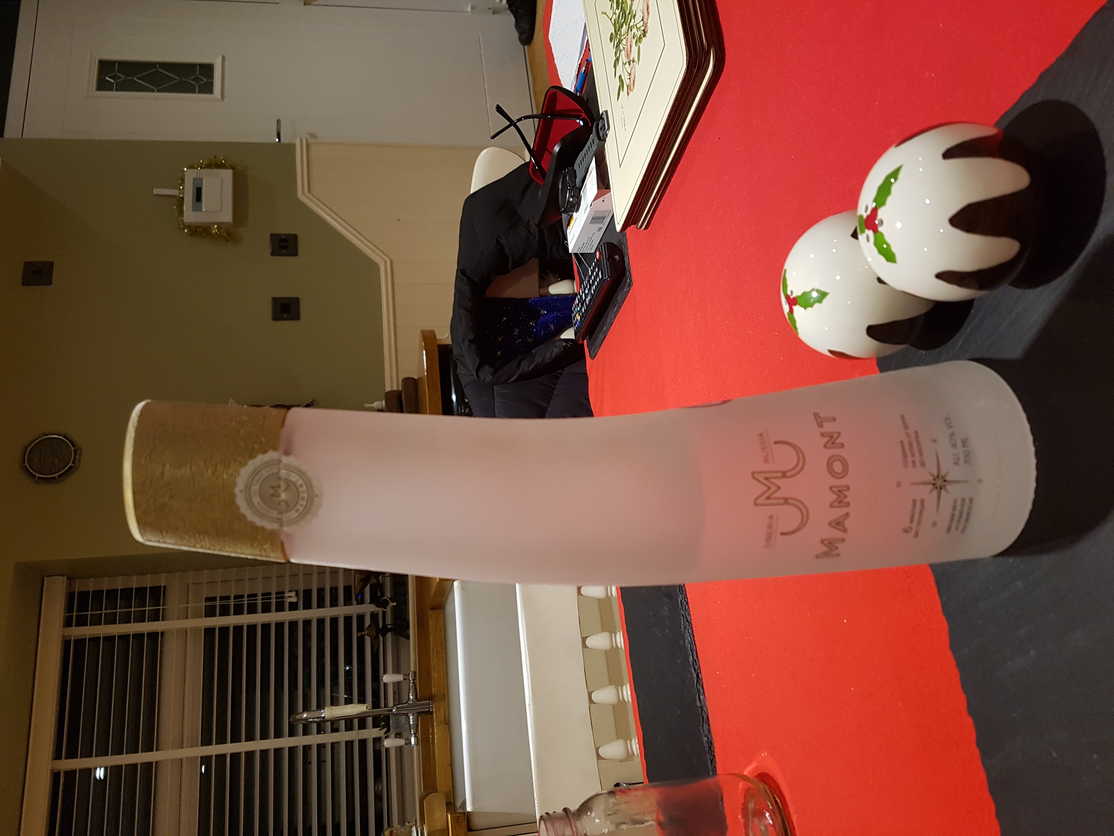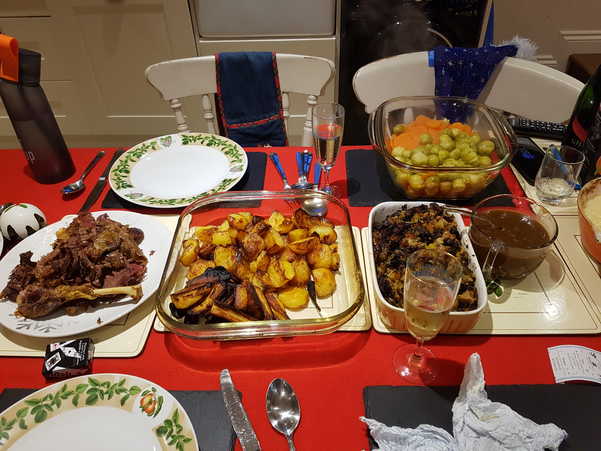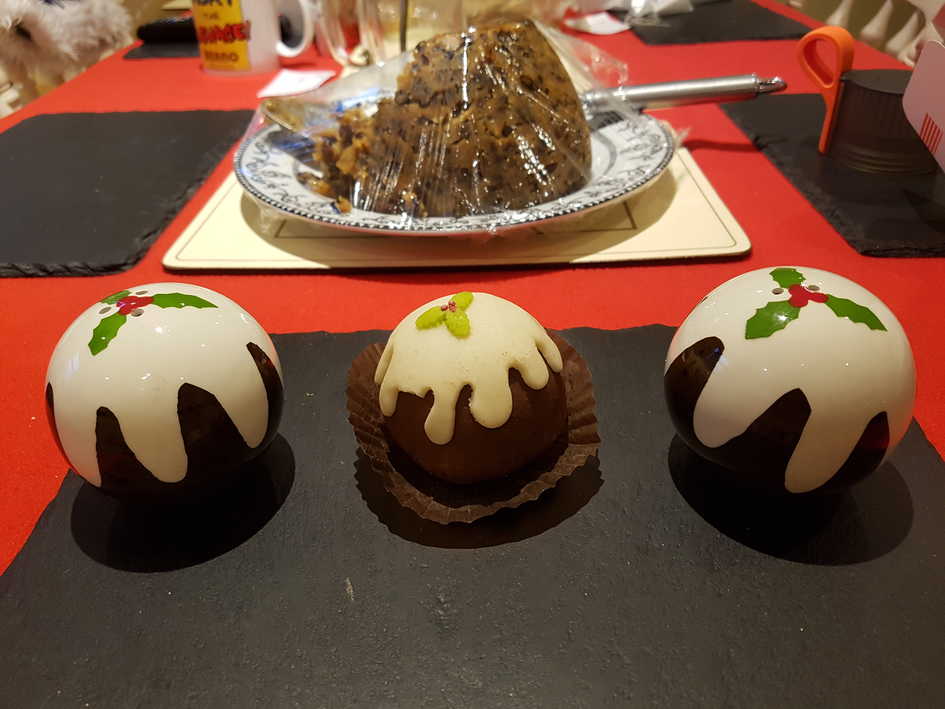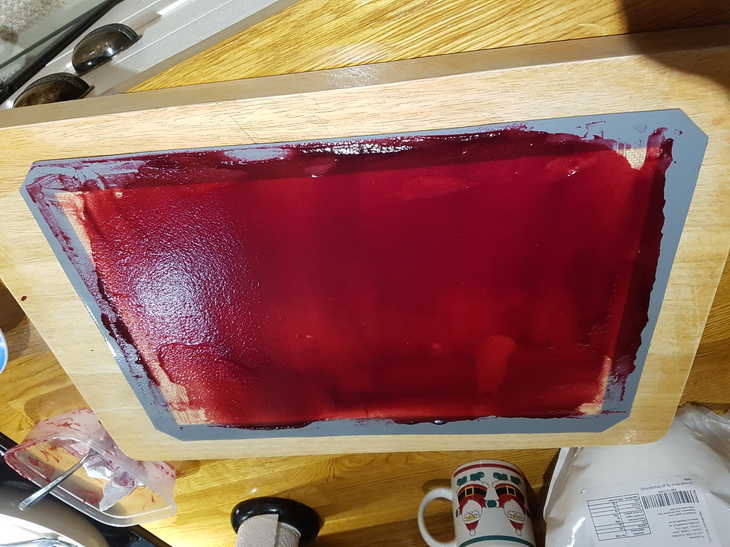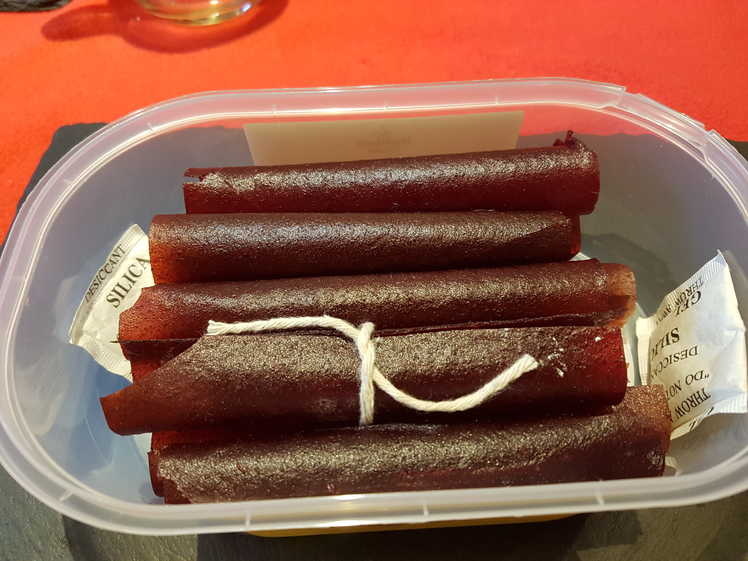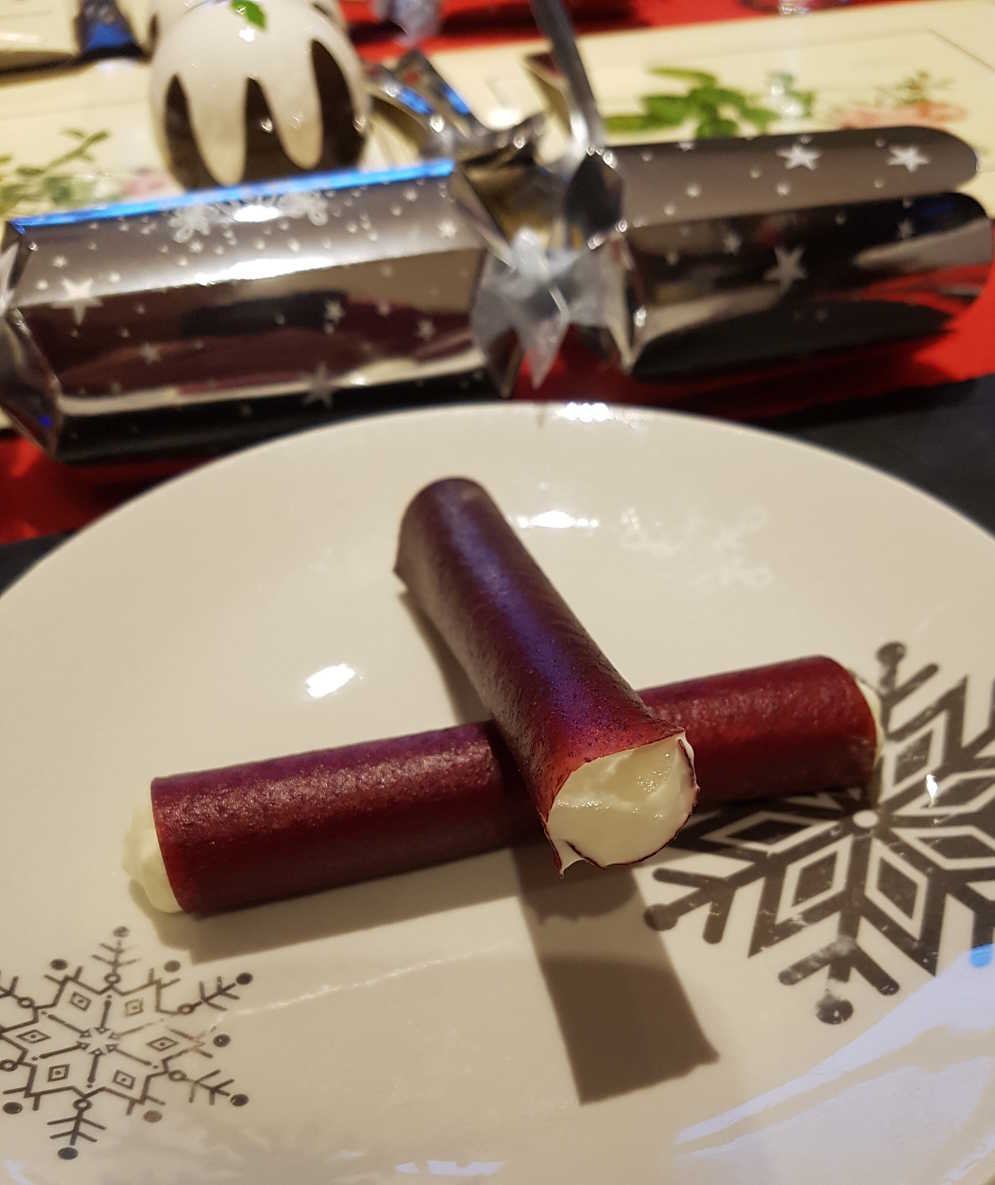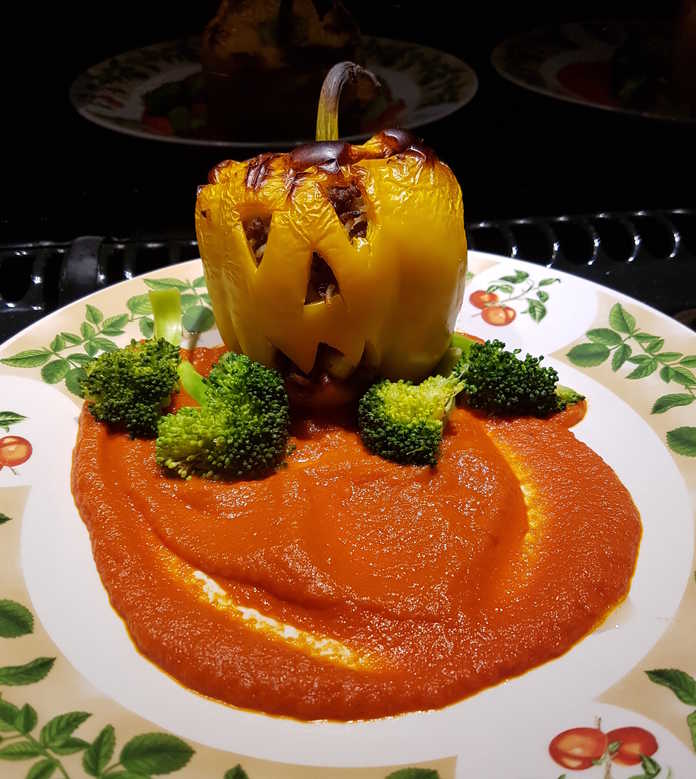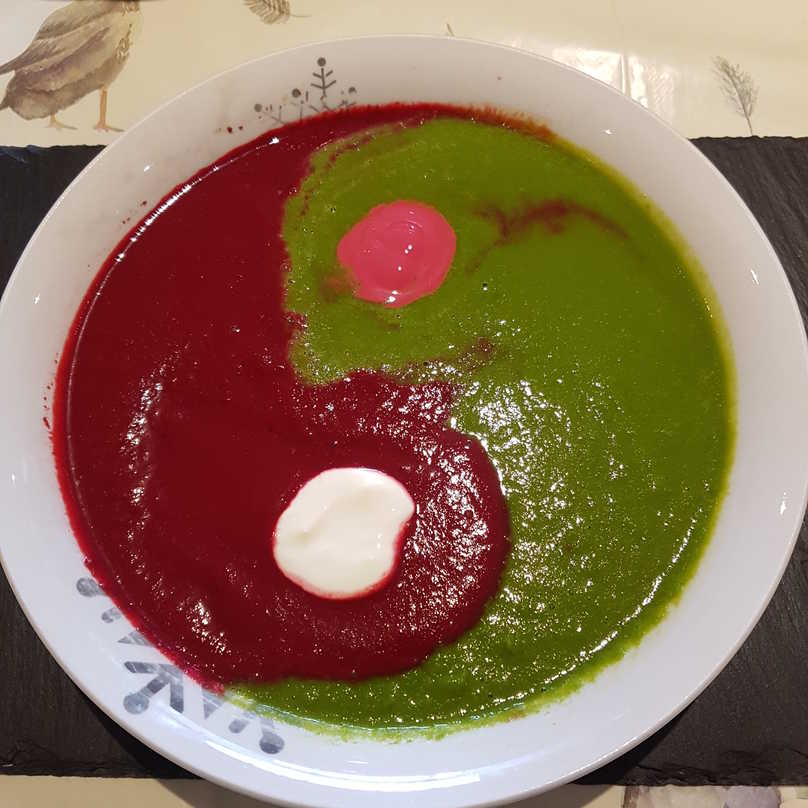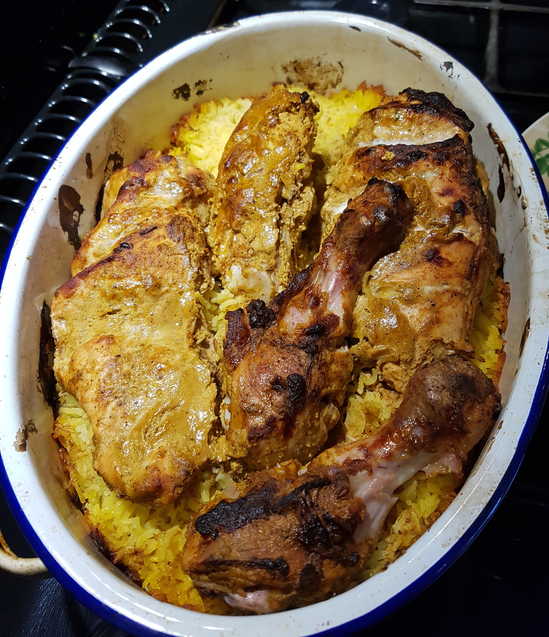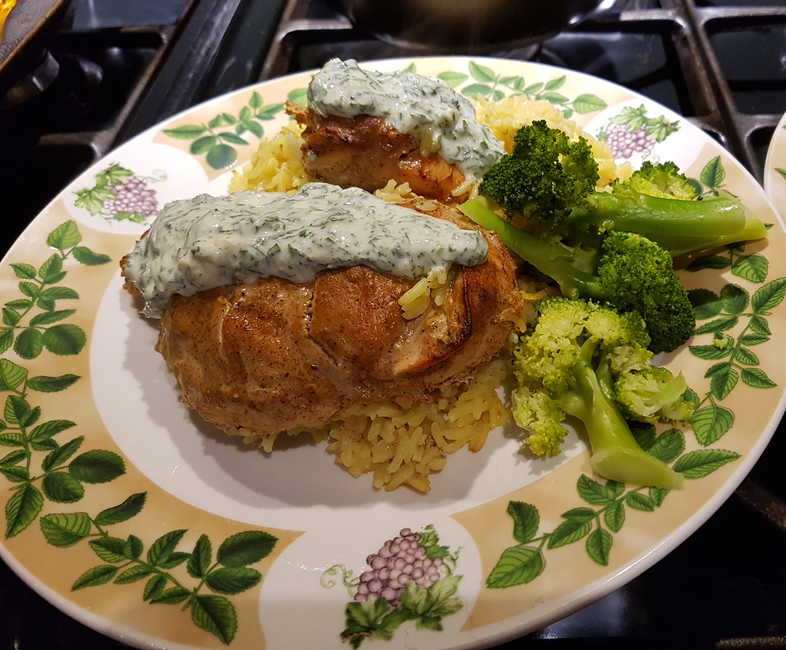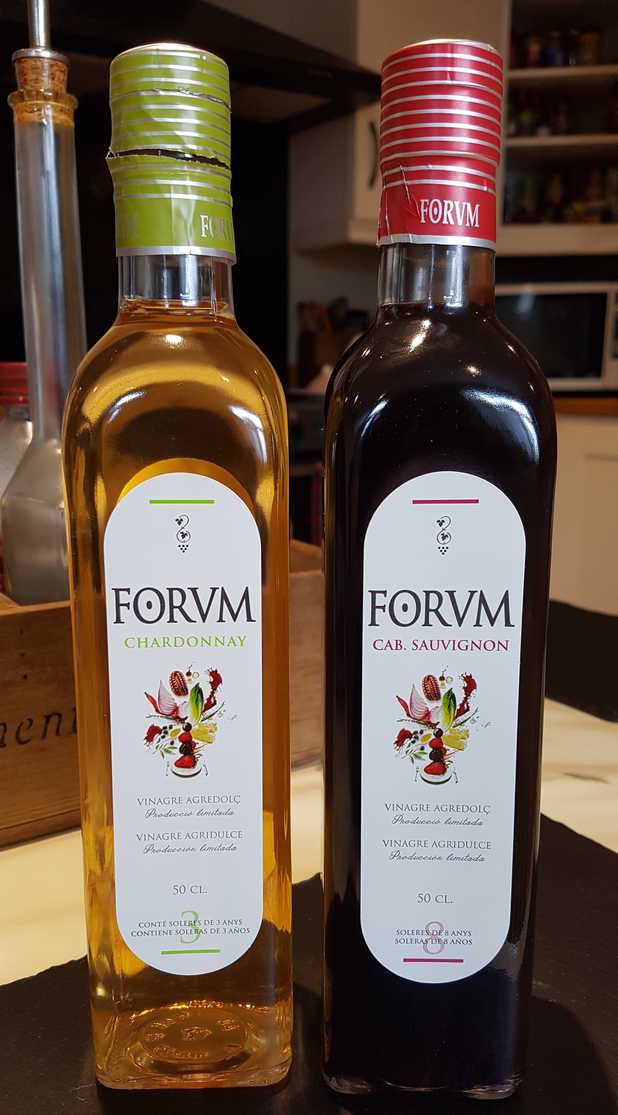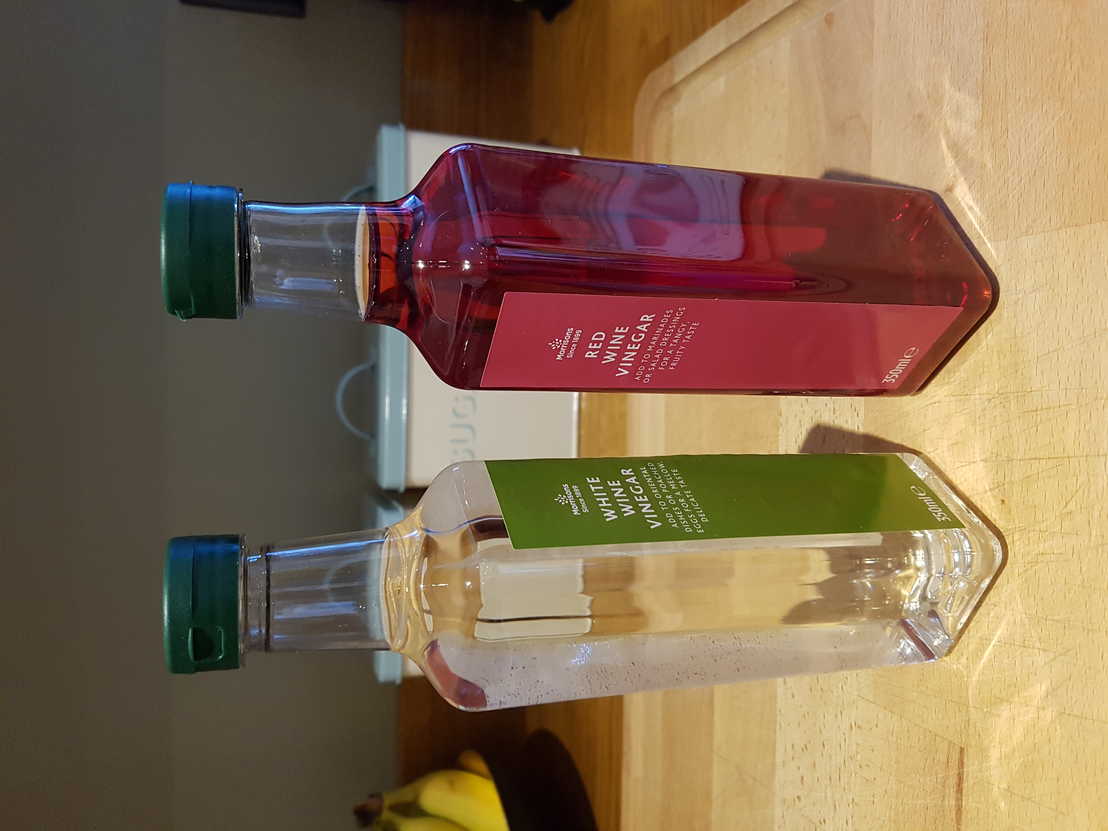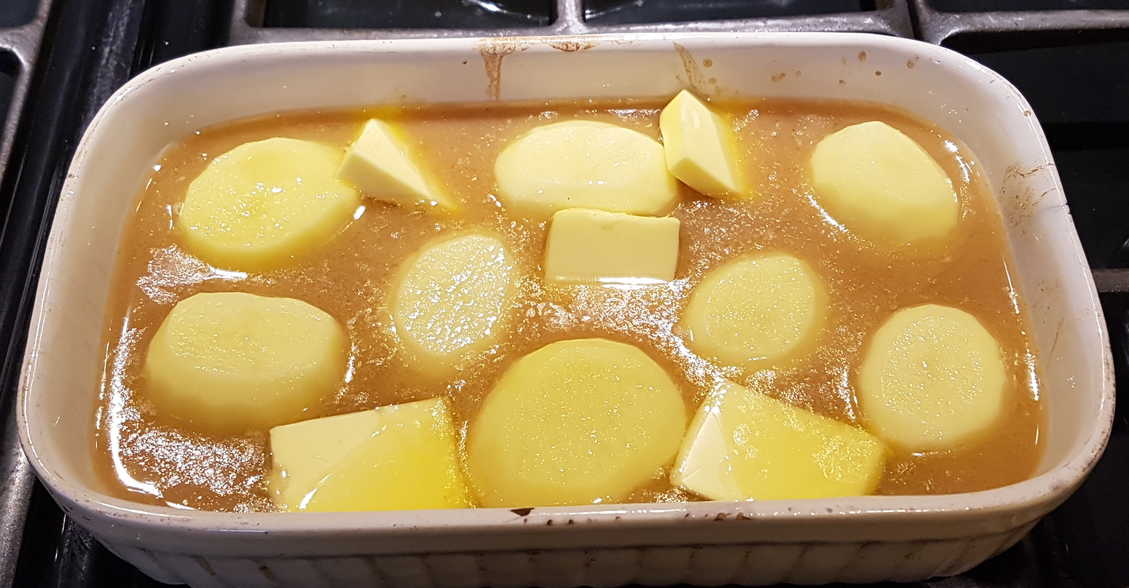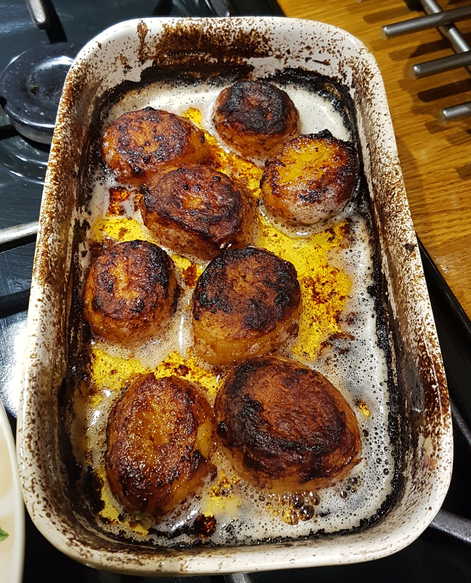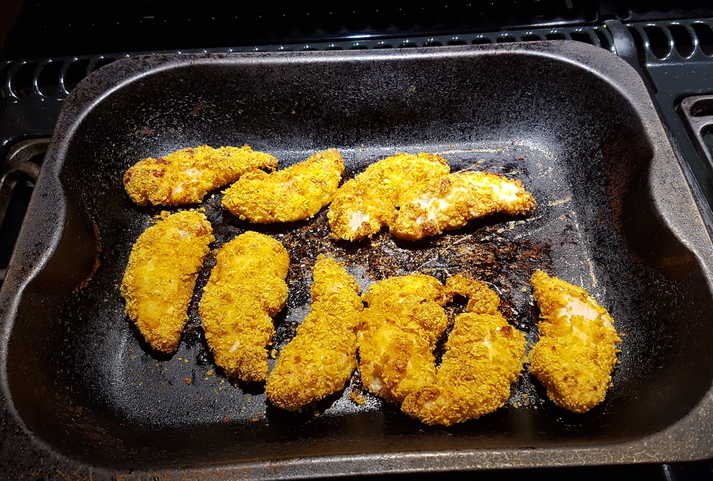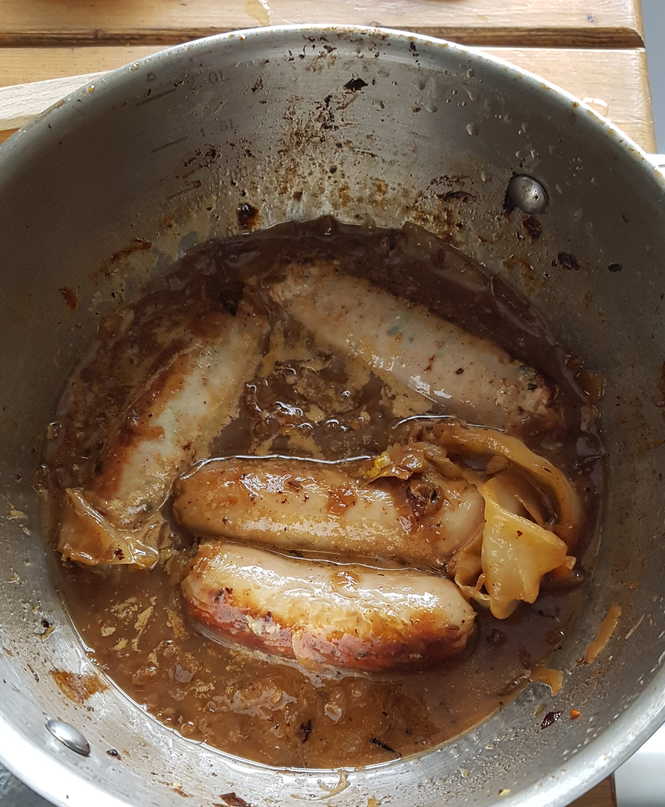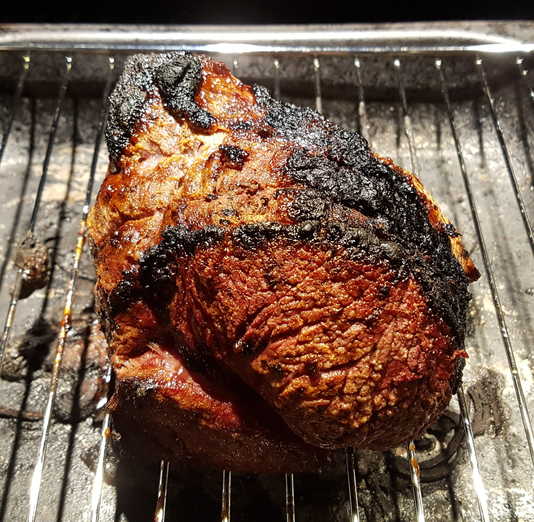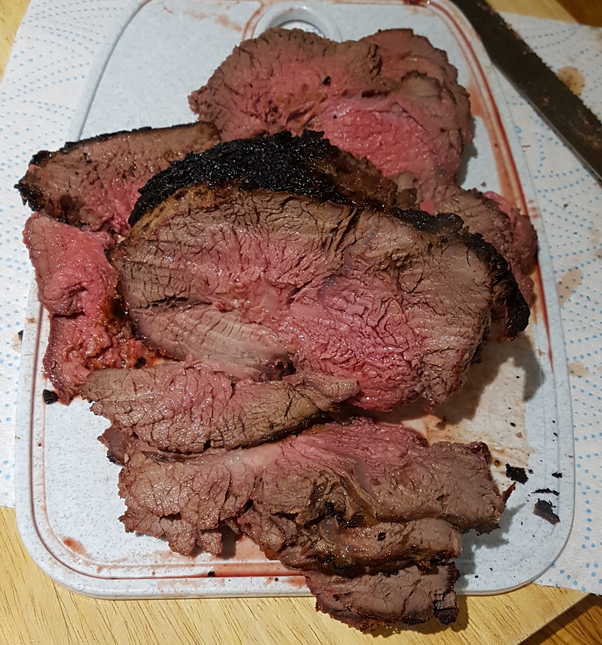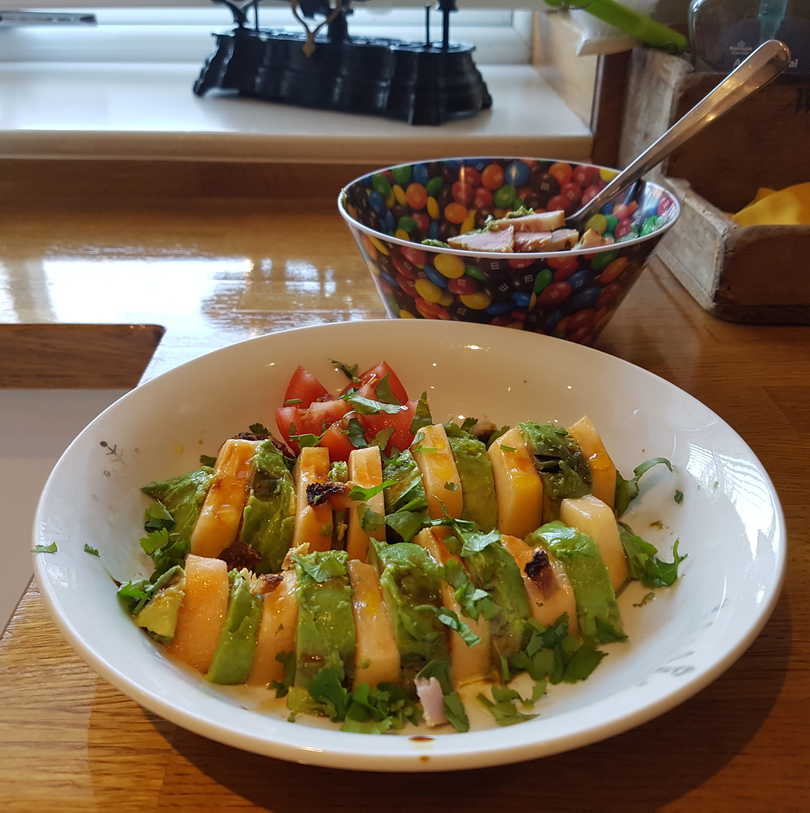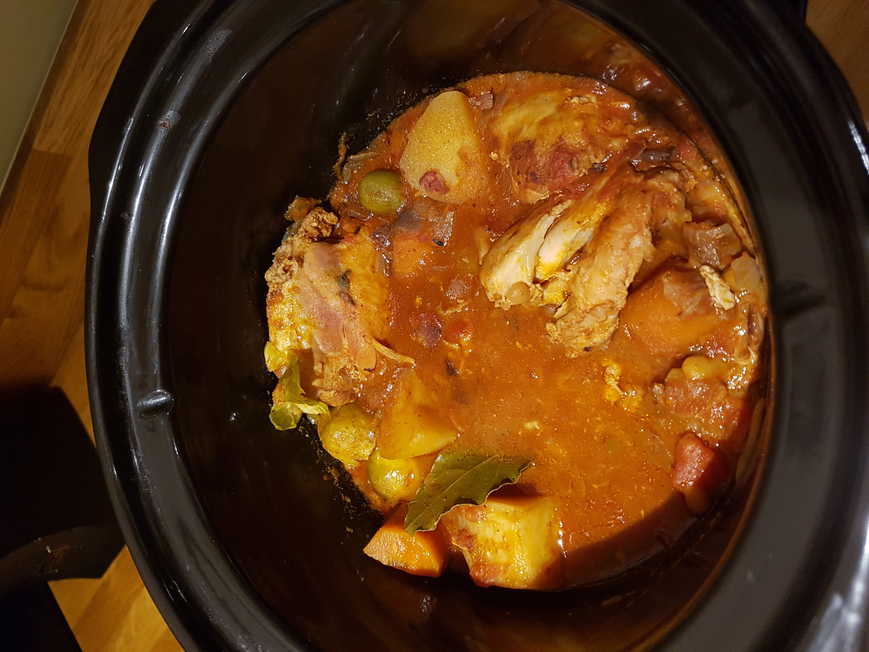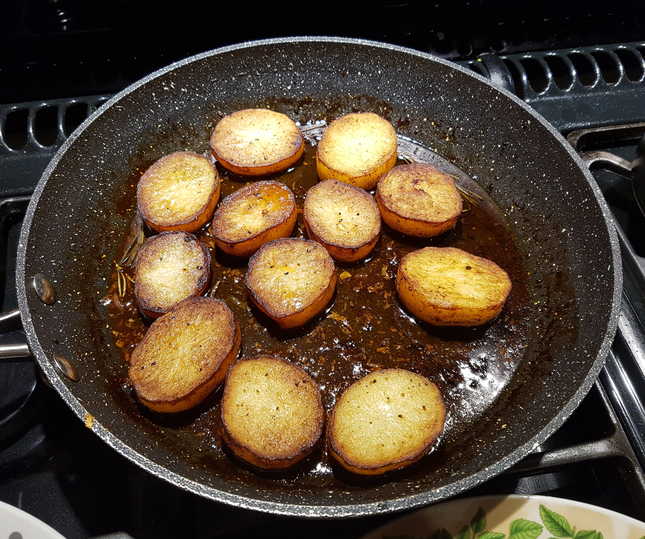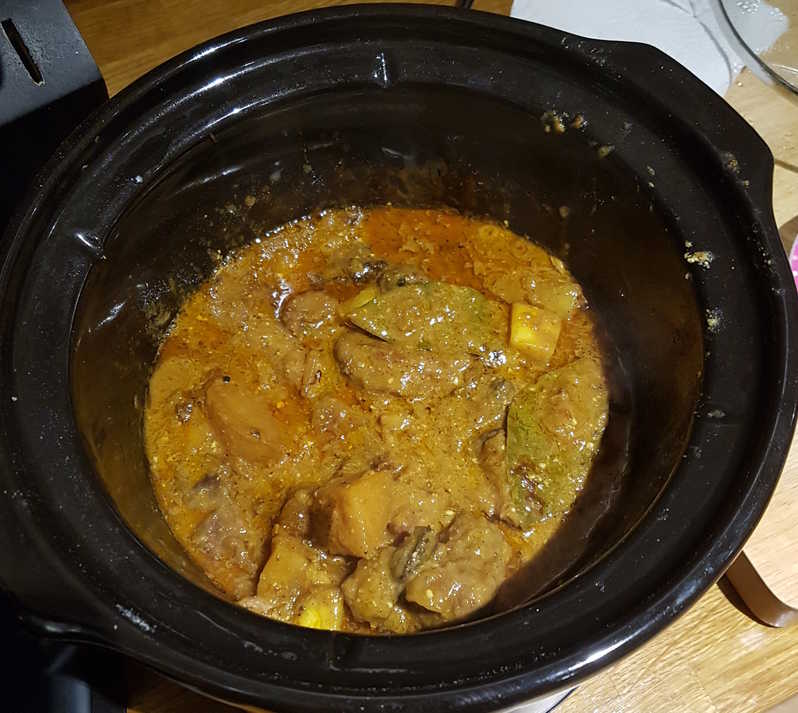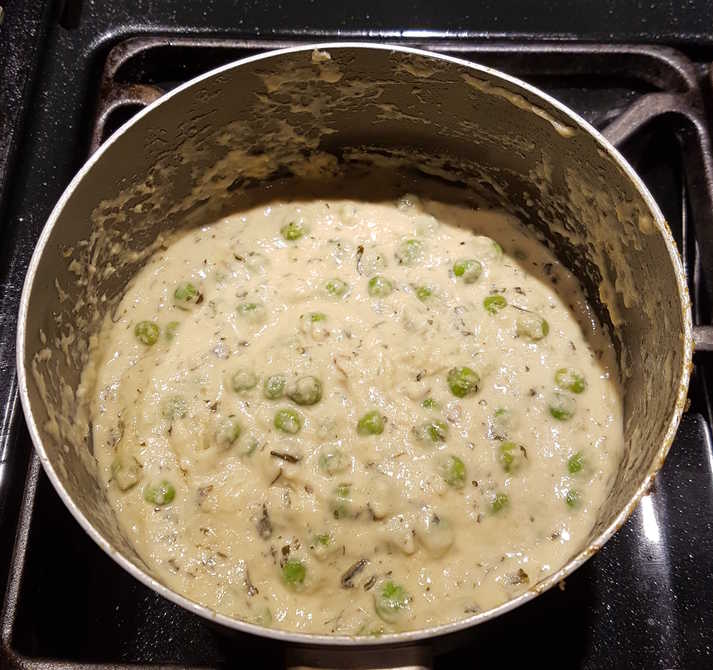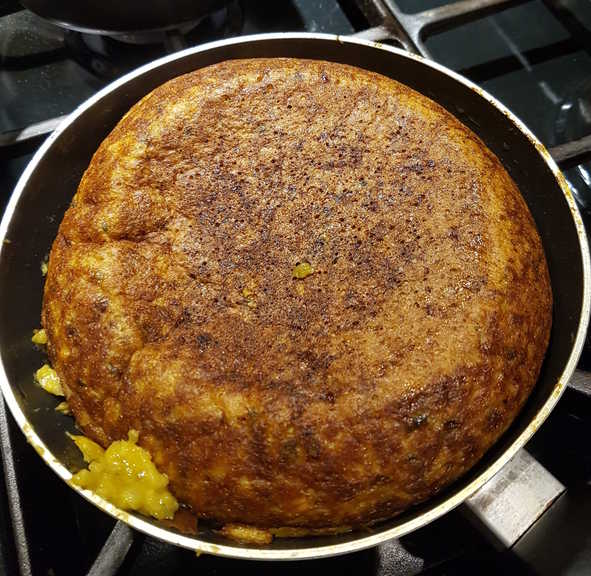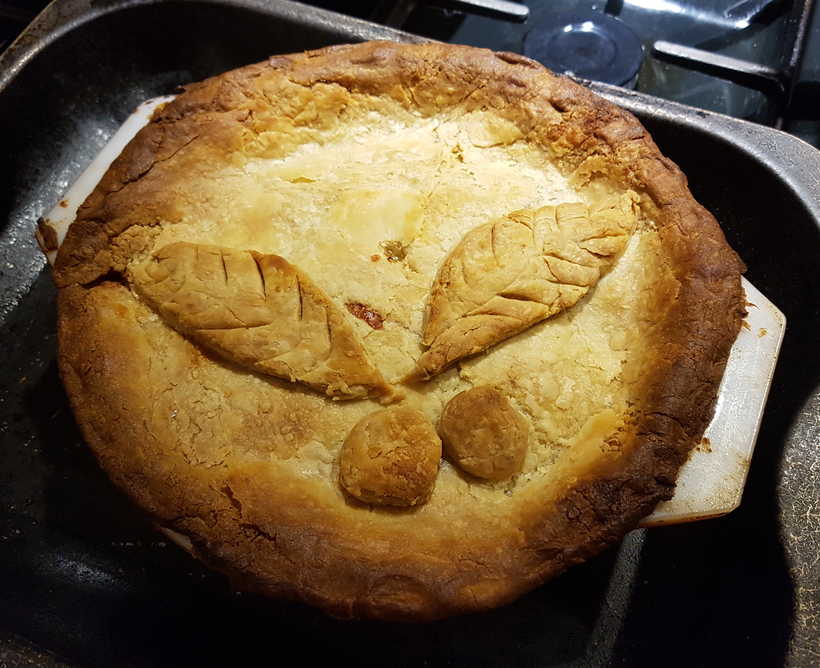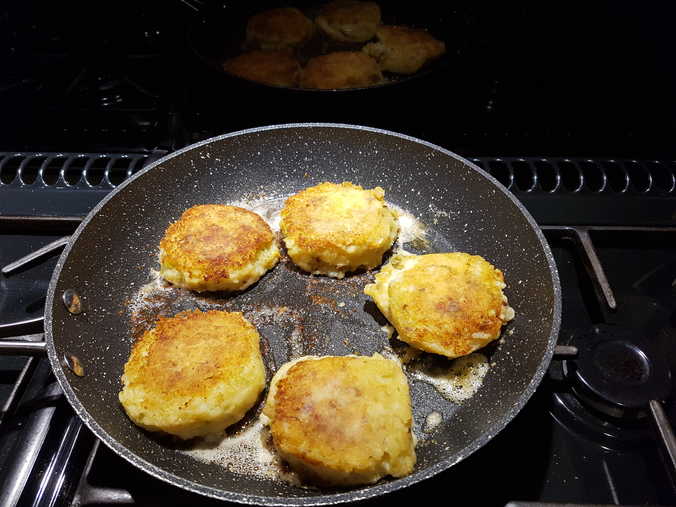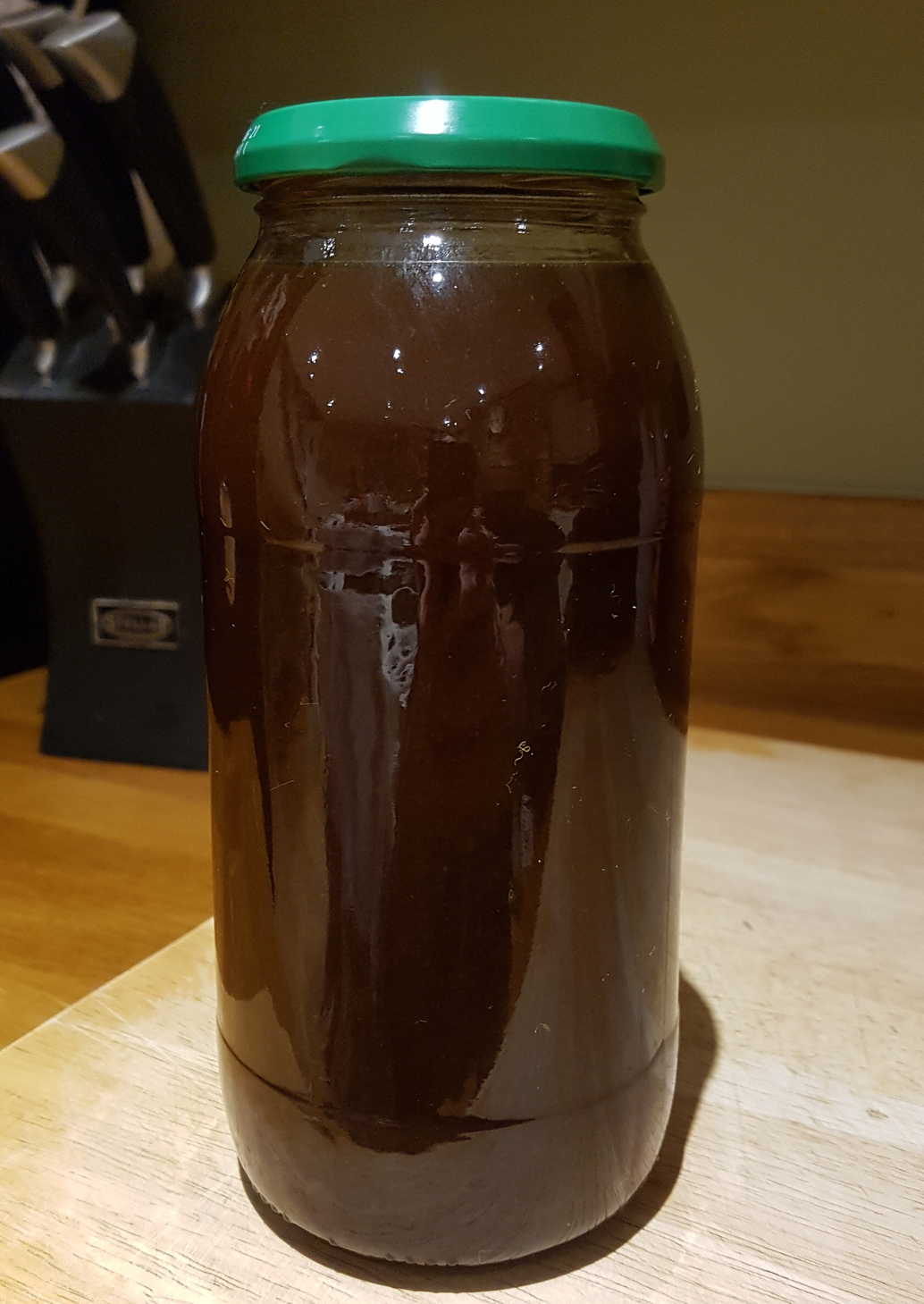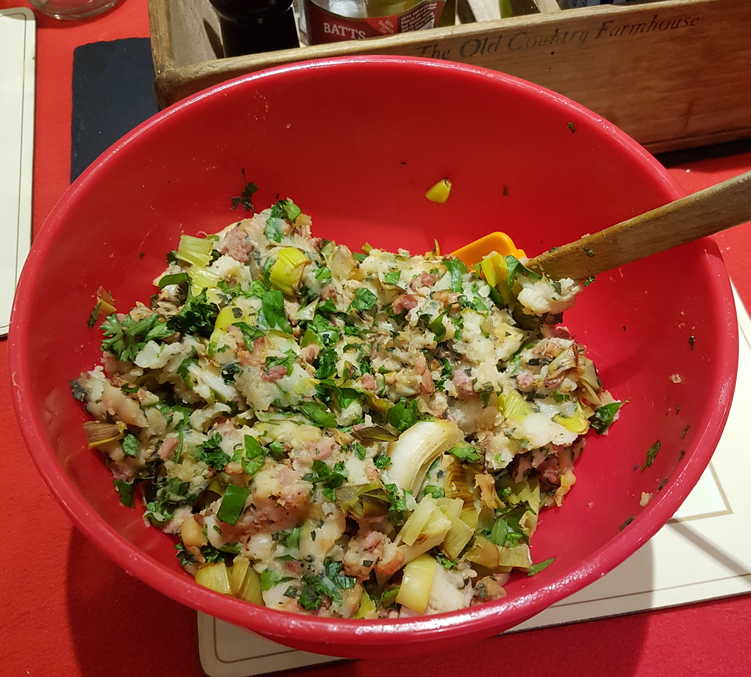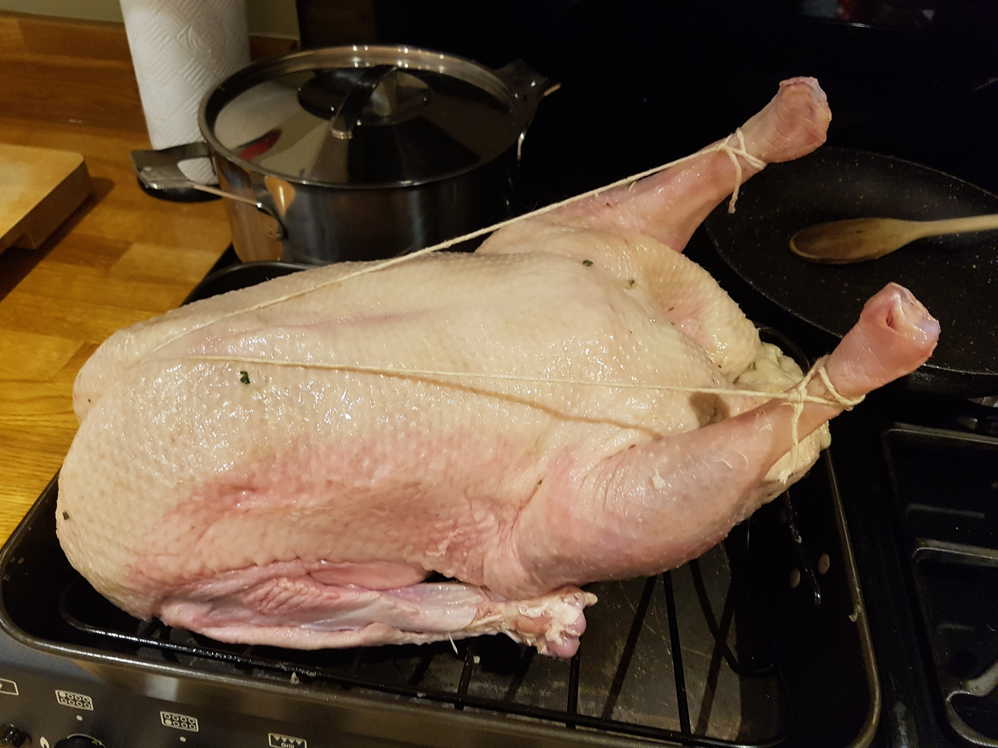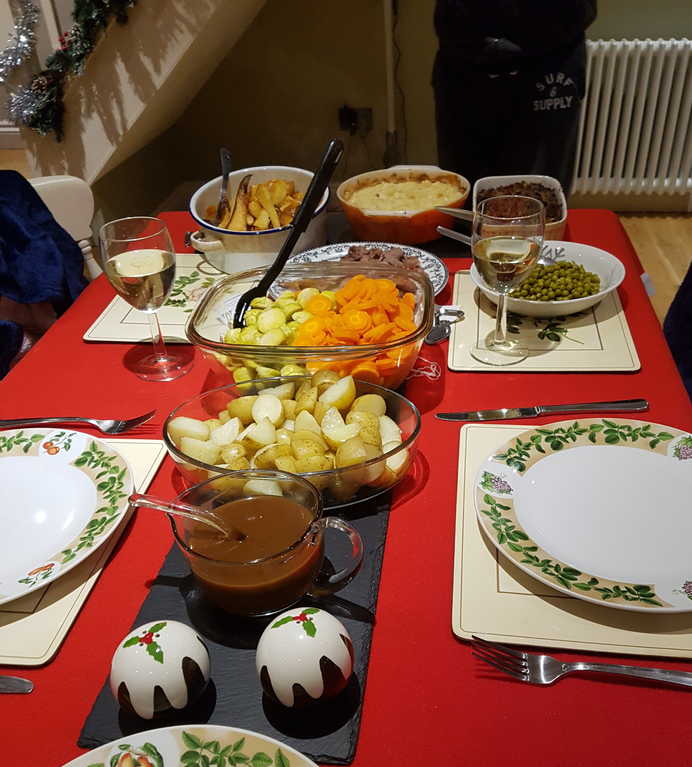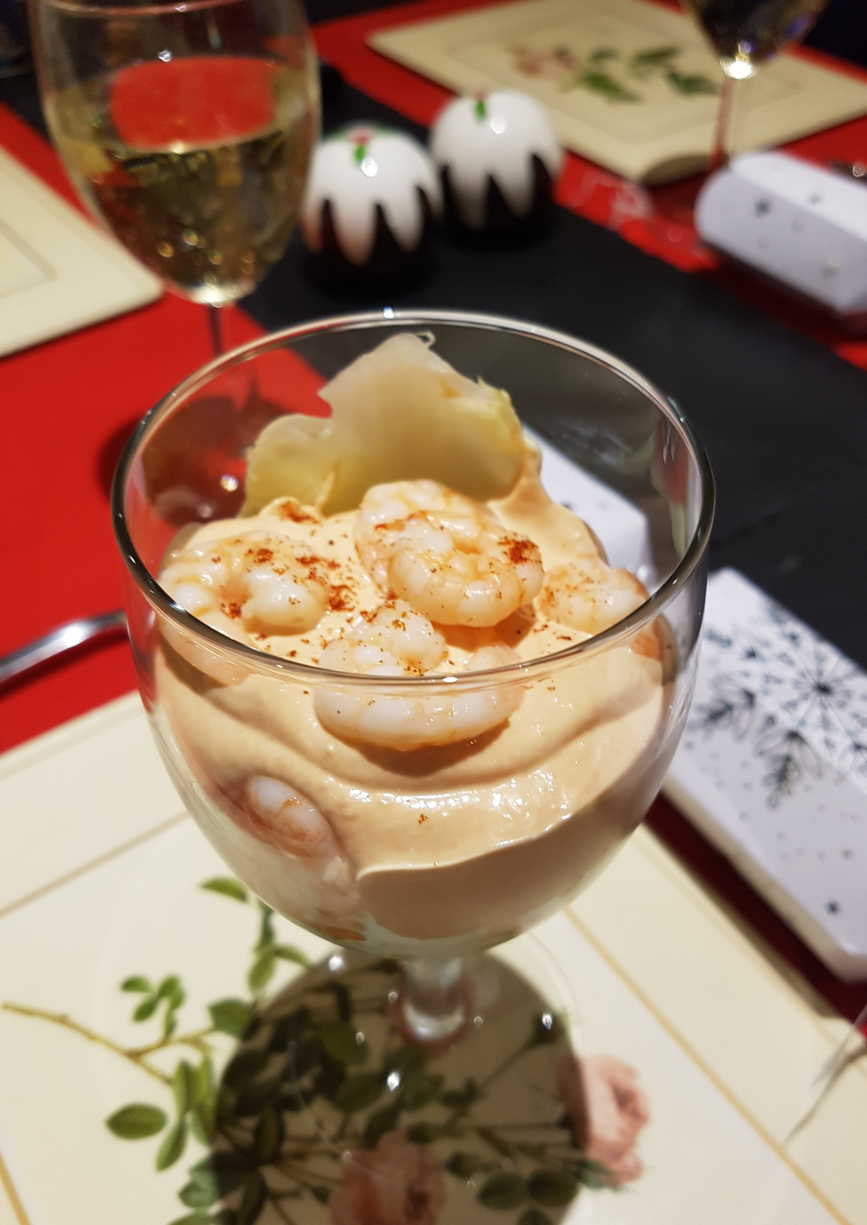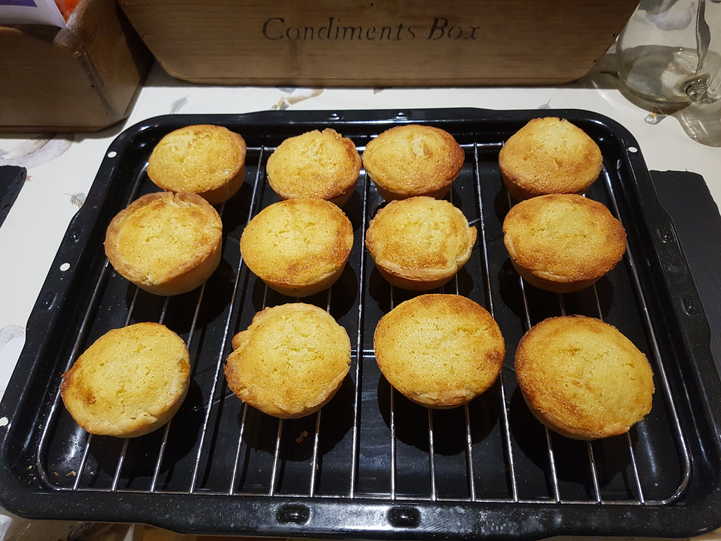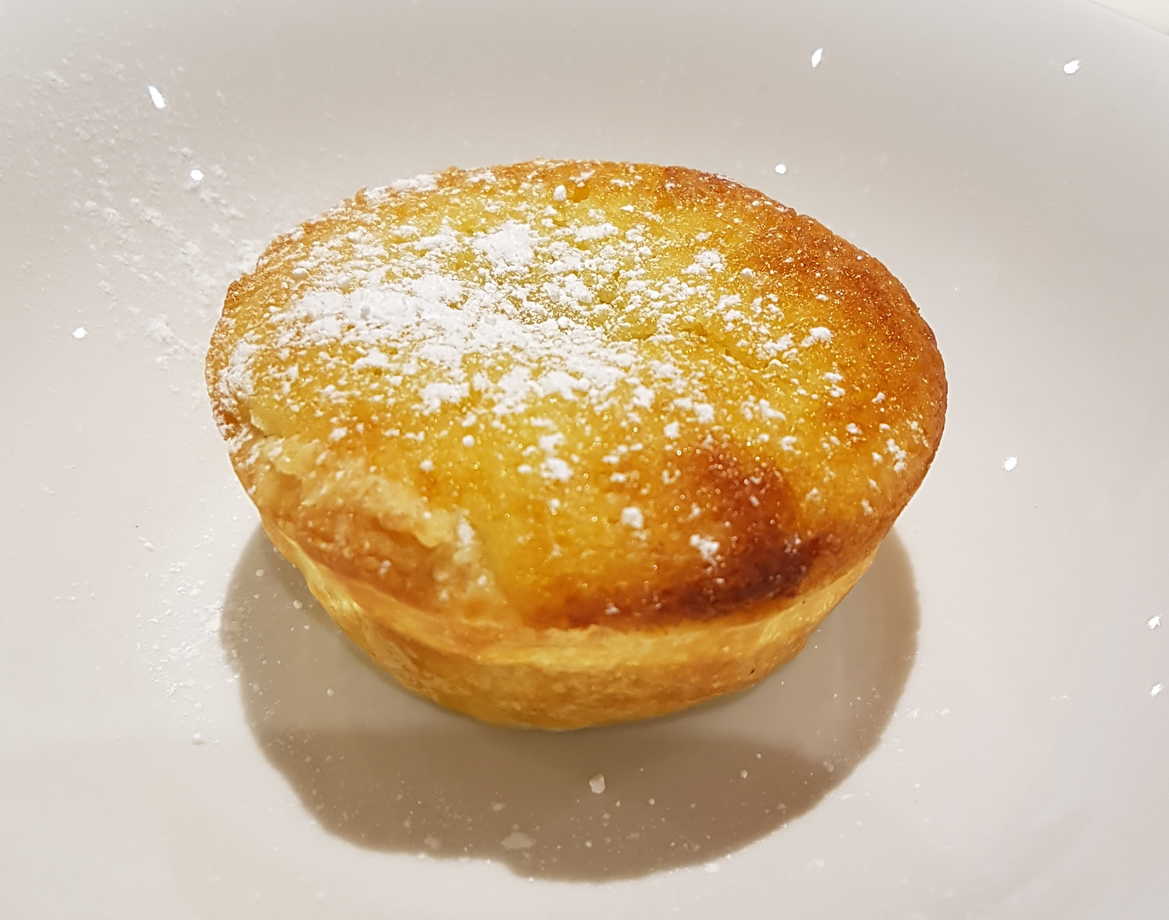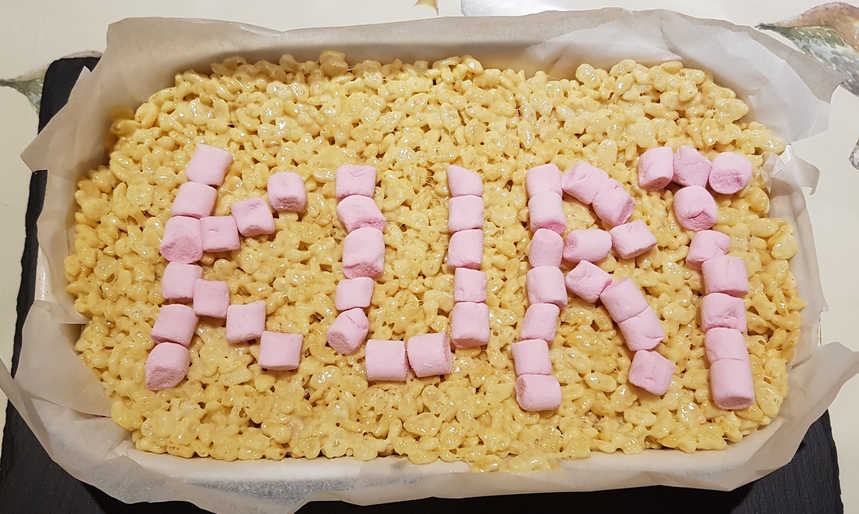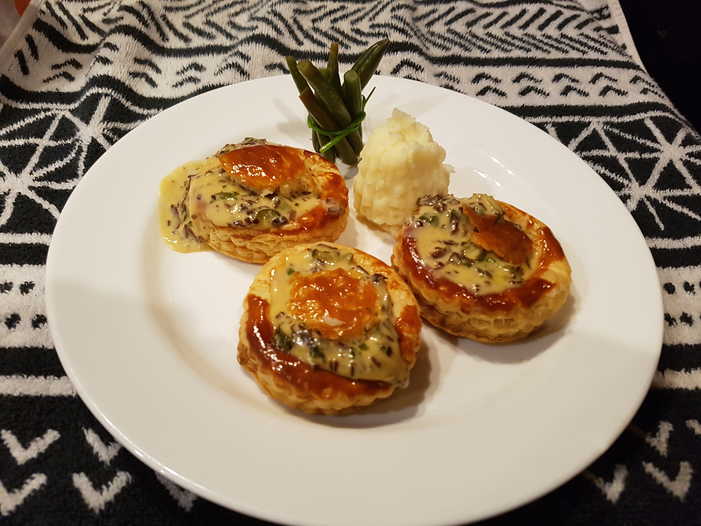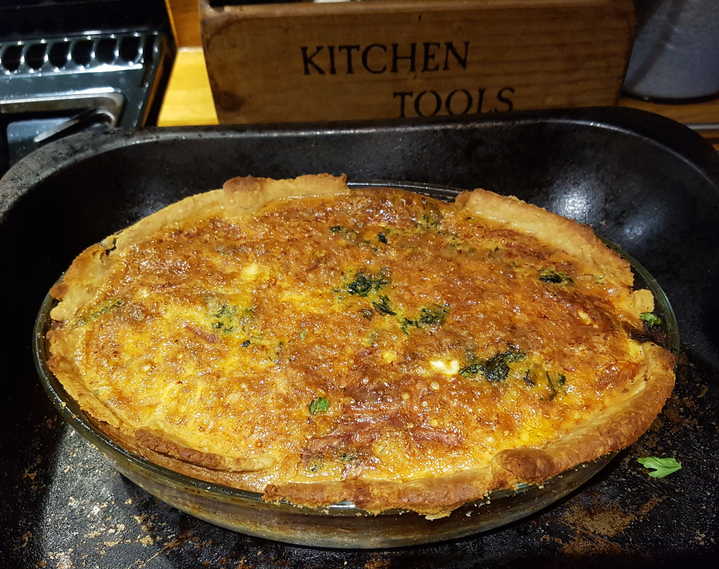
He's Not Dead!

He's resting.
Pining for the fjords.
But he's still cooking. So maybe I'll just leave all these recipes here. Until I get motivated to record the hilarious anecdotes which go with them.
Comments (1)
I'm Dreaming of a White Day Within the Window of Christmas

Well it snowed. Feebly. Early on Boxing Day morning.
Wooo!
When I was a kid it snowed on Christmas Day every year. All day. Just like in the bible.
How I miss those classic Christian holidays 😢
Well, you know the drill by now - presents, drink, comedy starter, goose dinner - table groaning under all the trimmings, crackers, pudding, grumpy child....
I got a rather spectacular bottle of Mammoth vodka this year Thanks Kurt! - so good it would have been criminal to mix it. And I found some rather fetching plum pudding cruets in a charity shop. Or was that last year. Anyway, don't they make a fine set?
My Christmas cracker this year had an unnecessarily challenging dingbat puzzle which took me two days to solve.
Now you can enjoy it too!
These are quality crackers mind - I've been putting my bottle opener gift to good use every bath night, though the hat was still shit.
To go with this year's infeasibly massive cheese hamper (pre-ordered from Czerwik's Wine & Cheesemonger don't you know) I also found some really good, limited edition, truffle flavoured crisps that I liked.
They've gone now. Hope they come back next year (looking at YOU Local Fucking Supermarket™).
In keeping with my old-fashioned views on appropriate yule weather, I still send snail-mail cards at Christmas. Due to the rate at which my old friends have started moving, or dying, this year I decided to write my return address on the back of all of them, just in case. Colour me surprised when the card I sent to my relatives in Canada was returned to sender - address unknown.
I've been sending a card to the same house for decades without adding a return address so who knows how long ago they quietly moved? Or died?
So Merry Christmas and a Happy 2022 wherever you are Aunty Dawn.
Ya Dick!
Cranberry Tuile with Stilton Foam
starter snack veg cheese
The original article's photos of this pretty red and white dish
looked perfect for Christmas, so I decided to give it a go.
As instructed I used a Grenache heavy fruity Côtes du Rhônes red wine, but I substituted 100g of mild and creamy blue cambazola for the stilton, since I was making it for diners who don't really like strong cheese and the foam I made was delicious. Though it did take two nitrous charges to foam properly, not the one.
Getting the purée spread smoothly and evenly and with the right thickness is the trickiest part. Except for rolling them into cigars. That's also the trickiest part 😉 I bought a smooth silicon mat which is pretty essential for the baking, and an extra-wide cake scraper for the purée spreading. This will make about enough purée to cover two 12" square baking sheets, producing about a dozen tuiles. (Or tuile-like shapes 🙂) But I think these would actually be better shorter than the 12cm suggested - maybe about half that length.
I didn't quite figure out the secret to always getting the tuiles uniformly crispy, as opposed to sadly leathery:
Obviously they need to be baked the correct amount of time - too little and they won't completely harden, too much and they'll shatter before you can roll them up. Which timing and success also depends on the thickness and even-ness of the layer you made.
And obviously they must then be stored in a dry environment - I added a couple of silica gel packets to a tupperware container which I stored in the fridge, though that may not have been ideal.
And even more obviously they must be served immediately after filling.
But there was still some variation in mine.
As instructed I used a Grenache heavy fruity Côtes du Rhônes red wine, but I substituted 100g of mild and creamy blue cambazola for the stilton, since I was making it for diners who don't really like strong cheese and the foam I made was delicious. Though it did take two nitrous charges to foam properly, not the one.
Getting the purée spread smoothly and evenly and with the right thickness is the trickiest part. Except for rolling them into cigars. That's also the trickiest part 😉 I bought a smooth silicon mat which is pretty essential for the baking, and an extra-wide cake scraper for the purée spreading. This will make about enough purée to cover two 12" square baking sheets, producing about a dozen tuiles. (Or tuile-like shapes 🙂) But I think these would actually be better shorter than the 12cm suggested - maybe about half that length.
I didn't quite figure out the secret to always getting the tuiles uniformly crispy, as opposed to sadly leathery:
Obviously they need to be baked the correct amount of time - too little and they won't completely harden, too much and they'll shatter before you can roll them up. Which timing and success also depends on the thickness and even-ness of the layer you made.
And obviously they must then be stored in a dry environment - I added a couple of silica gel packets to a tupperware container which I stored in the fridge, though that may not have been ideal.
And even more obviously they must be served immediately after filling.
But there was still some variation in mine.
Makes about 8-12 of the full-length tuiles.
Ingredients
Cranberry tuile:- 20g of Isomalt sugar you can use up to 30g I reckon
Cranberry purée:- 200ml of red wine
- 250g of frozen cranberries
- 4 tbsp of caster sugar
Stilton foam:- 95g of Colston Basset stilton or something milder
- 250ml of double cream
- 150ml of whole milk
- 1 pinch of salt
To make the cranberry purée, bring the wine to a boil and reduce it to 75ml.
Place the cranberries in a pan and pour over the reduced red wine whilst still hot. Bring to the boil, reduce the heat and cook until the cranberries start to collapse.
Whizz in a food blender until smooth.
Pass through a fine sieve, add sugar to taste, and cool. Store until required.
To make the cranberry tuile, heat the oven to 90°C. Put the cranberry purée and Isomalt sugar up to 30g seems to be fine, maybe even better into a pan and place on the stove, warming just enough for the sugar to dissolve, stirring continuously.
Pour onto a silicon baking mat and, using a 24cm/12inch step pallet knife, spread a thin, even layer of the mixture over the surface of the mat.
Cook for 45 - 50 minutes or until set.
Once set, remove from the oven and carefully peel the sheet of tuile off the mat and put it on a board. Cut out 6cm x 12cm 6cm x 7cm? rectangles and return these to the mat, shiny side down.
Put back into the oven and continue drying for a further 45 minutes or longer.
Place the cranberries in a pan and pour over the reduced red wine whilst still hot. Bring to the boil, reduce the heat and cook until the cranberries start to collapse.
Whizz in a food blender until smooth.
Pass through a fine sieve, add sugar to taste, and cool. Store until required.
To make the cranberry tuile, heat the oven to 90°C. Put the cranberry purée and Isomalt sugar up to 30g seems to be fine, maybe even better into a pan and place on the stove, warming just enough for the sugar to dissolve, stirring continuously.
Pour onto a silicon baking mat and, using a 24cm/12inch step pallet knife, spread a thin, even layer of the mixture over the surface of the mat.
Cook for 45 - 50 minutes or until set.
Once set, remove from the oven and carefully peel the sheet of tuile off the mat and put it on a board. Cut out 6cm x 12cm 6cm x 7cm? rectangles and return these to the mat, shiny side down.
Put back into the oven and continue drying for a further 45 minutes or longer.
Mine took about an hour the first round and maybe a bit longer the second.
On the first round you want the sheet to be firm enough to hold together when you peel it off the silicon mat, but pliable enough to not break when you bend or cut it. I found it easiest to turn the silicon baking mat upside down, carefully pry loose one end of the sheet with a knife and then peel the mat away from from the cranberry sheet, rather than the other way around.
For the second round you need the rectangles just soft enough to work with, but for them to quickly harden up in perhaps 30 seconds. I peeled off one rectangle at a time from the baking sheet inside the oven, leaving the others there while I rolled that rectangle up. Then you don't need to rush, or worry about the others setting too soon.
While the tuiles are still warm wrap them around 12cm long metal tubes that are 2cm in diameter.
As the tuiles cool you can remove the tube and they will crisp up. Store in an airtight container until required.On the first round you want the sheet to be firm enough to hold together when you peel it off the silicon mat, but pliable enough to not break when you bend or cut it. I found it easiest to turn the silicon baking mat upside down, carefully pry loose one end of the sheet with a knife and then peel the mat away from from the cranberry sheet, rather than the other way around.
For the second round you need the rectangles just soft enough to work with, but for them to quickly harden up in perhaps 30 seconds. I peeled off one rectangle at a time from the baking sheet inside the oven, leaving the others there while I rolled that rectangle up. Then you don't need to rush, or worry about the others setting too soon.
Oh, you can remove the tube can you?
I tried everything to prevent the rolled candy from sticking to my metal tube (except trying a wooden one?) - wiping it with a damp cloth (obviously a bad idea), brushing it with icing sugar, greasing it lightly with oil. Nothing worked.
In the end I just used the pipe as a loose guide for the rolling process, never pressing the tuile too firmly against the metal. Some of the cylinders stiffened up almost immediately, but I also had on hand some short pieces of string to tie around those which took a little longer to harden while I got on with the next one.
You need the candy rectangles to be wide enough to either overlap when rolled or have the ends just meet and press together. It's probably better to overlap the roll a little so there's no gap for the foam to squirt out of when you fill them. After a practice round I cut mine wider than suggested at 7cm to (gently) wrap around a 2cm diameter tube.
To make the Stilton foam, bring the milk and cream up to the boil, reduce the heat, add the cheese and allow to melt.
Mix using a hand blender, then pass the mixture through a fine sieve.
Pour into a ½ litre espuma gun, turn upside down, and charge once or twice! with an ISI charger.
Shake lightly and store in the fridge until required.
I tried everything to prevent the rolled candy from sticking to my metal tube (except trying a wooden one?) - wiping it with a damp cloth (obviously a bad idea), brushing it with icing sugar, greasing it lightly with oil. Nothing worked.
In the end I just used the pipe as a loose guide for the rolling process, never pressing the tuile too firmly against the metal. Some of the cylinders stiffened up almost immediately, but I also had on hand some short pieces of string to tie around those which took a little longer to harden while I got on with the next one.
You need the candy rectangles to be wide enough to either overlap when rolled or have the ends just meet and press together. It's probably better to overlap the roll a little so there's no gap for the foam to squirt out of when you fill them. After a practice round I cut mine wider than suggested at 7cm to (gently) wrap around a 2cm diameter tube.
I let my mixture cool in the foamer before sealing and charging. I don't know if it makes any difference.
To serve, fill the tubes with the Stilton foam using the espuma gun.
Arrange on a plate or bowl, and serve immediately.
Most excellent!
Though an awful lot of trouble for a couple of tuiles per person!
Leftover Christmas Quiche
main fowl cheese
Stuff all your leftover Christmas into one glorious quiche!
I had goose stuffing, herbs, cheese (no, not all my good Christmas cheeses - just the rubbish ones - Lancashire, some cheap cheddar, and a goat brie) and, bizarrely, spinach.
I had goose stuffing, herbs, cheese (no, not all my good Christmas cheeses - just the rubbish ones - Lancashire, some cheap cheddar, and a goat brie) and, bizarrely, spinach.
Serves 6
Ingredients
For the Pastry:- 6 oz plain flour
- 3 oz lard or butter, chilled, diced
- ½ tsp salt
- a few spoons cold water
For the Filling:- 200ml double cream
- 50-100ml milk
- 4-5 eggs
- salt &pepper
- cheese, sliced or grated
- Christmas leftovers
Sift the flour into a bowl, sprinkle in a little salt, and quickly rub in the diced fat. Don't overwork it.
When you reach coarse breadcrumbs, gradually cut in cold water with a knife until the mixture begins to cohere.
Gather into a ball, wrap in clingfilm and chill for half an hour.
Preheat the oven to 200°C/Gas Mark 6.
Roll out the dough and line a quiche dish or in my case a ludicrously deep oven dish. Chill again for 30 minutes if you can be bothered. Prick all over with a fork, line with baking paper or foil, fill with baking beans and bake in the centre of the oven for 10 minutes. Remove the beans and paper, return to the oven and bake for a further 10 minutes until the pastry is cooked and colouring lightly.
Turn the oven down to 180°C/Gas Mark 5 or lower, if you have a deep, fat quiche like mine.
Cover the base of the quiche with your chopped Christmas leftovers.
Whisk the egg with the milk and cream. Season with salt & pepper. Pour into the quiche to fill it up.
Test with a skewer to make sure the centre is hot. Don't overcook it though.
Serve hot or warm.
When you reach coarse breadcrumbs, gradually cut in cold water with a knife until the mixture begins to cohere.
Gather into a ball, wrap in clingfilm and chill for half an hour.
Preheat the oven to 200°C/Gas Mark 6.
Roll out the dough and line a quiche dish or in my case a ludicrously deep oven dish. Chill again for 30 minutes if you can be bothered. Prick all over with a fork, line with baking paper or foil, fill with baking beans and bake in the centre of the oven for 10 minutes. Remove the beans and paper, return to the oven and bake for a further 10 minutes until the pastry is cooked and colouring lightly.
Turn the oven down to 180°C/Gas Mark 5 or lower, if you have a deep, fat quiche like mine.
Cover the base of the quiche with your chopped Christmas leftovers.
I had a layer of stuffing, and then spinach which I microwaved on high for 1 minute then minced.
And various chopped herbs.
Scatter with your grated or sliced (as for a Brie) cheese.Whisk the egg with the milk and cream. Season with salt & pepper. Pour into the quiche to fill it up.
If you end up with insufficient liquid you should go back in time and use more eggs, milk, or cream in your mixture.
Put the dish on a baking sheet and bake for about 30 minutes or more like an hour for a deep dish until the custard is golden on top and set.Test with a skewer to make sure the centre is hot. Don't overcook it though.
Serve hot or warm.
Well, mine was pretty tasty. Like Christmas itself, your mileage may vary.
It's Raining Leaves!

Hallelujah!
Autumn has arrived abruptly. I went from running my blessed air conditioner to putting on extra jumpers almost, it seems, overnight.
Just in time for the fuel and gas shortages.
I feel a bleak midwinter coming.
I made a flying visit to Edinburgh to visit Flora, get some decent food courtesy of another fine dinner at Martin Wishart's Thanks Martin! and fit in a day's nostalgic sailing on Yacht Erin.
Edinburgh was strangely subdued for festival week having been terrified into submission by Scotland's First Minister - a horror film hybrid of an authoritarian Angela Merkel and bumbling Janette Krankie.
Quite a nice change to be able to get a seat in the pubs and bars if I'm honest. Not so easy to get a table at any up-market restaurant though where, one supposes, the lockdown-rich and isolated are now spending all their time and money. Or, it turns out, a berth on a boat loaded with risk-averse COVID hysterics who, despite being thoroughly vaccinated, are irrationally terrified of anyone who isn't.
Flora was game though, so we had fun anyway. I introduced her to the BBC's Ghosts and she cooked an excellent steak dinner for me and her friend Mini-Flora.
Flora's Dad(RIP) was a master of understated, unfussy but expert home cooking and his fillet steak dinners were a staple.
Flora did him proud, with a little help from my creamy chanterelles and nutty brown cavolo nero.
I feel a bleak midwinter coming.
I made a flying visit to Edinburgh to visit Flora, get some decent food courtesy of another fine dinner at Martin Wishart's Thanks Martin! and fit in a day's nostalgic sailing on Yacht Erin.
Edinburgh was strangely subdued for festival week having been terrified into submission by Scotland's First Minister - a horror film hybrid of an authoritarian Angela Merkel and bumbling Janette Krankie.
Quite a nice change to be able to get a seat in the pubs and bars if I'm honest. Not so easy to get a table at any up-market restaurant though where, one supposes, the lockdown-rich and isolated are now spending all their time and money. Or, it turns out, a berth on a boat loaded with risk-averse COVID hysterics who, despite being thoroughly vaccinated, are irrationally terrified of anyone who isn't.
Flora was game though, so we had fun anyway. I introduced her to the BBC's Ghosts and she cooked an excellent steak dinner for me and her friend Mini-Flora.
Flora's Dad(RIP) was a master of understated, unfussy but expert home cooking and his fillet steak dinners were a staple.
Flora did him proud, with a little help from my creamy chanterelles and nutty brown cavolo nero.
Hallowe'en Stuffed Peppers
main meat cheese
I fancied the idea of a novelty Hallowe'en dinner for the young Philistine,
and so I riffed on Chef John's recipe for pepper Jack-O'-Lanterns.
I didn't have orange peppers, so I substituted yellow ones. I don't remember the pepper stuffing I used, probably some leftovers, nor do I now remember which of my many tomato sauce options I made - just be sure to make it good and blood red.
I thought they looked rather fine. The ingrate was not impressed.
I didn't have orange peppers, so I substituted yellow ones. I don't remember the pepper stuffing I used, probably some leftovers, nor do I now remember which of my many tomato sauce options I made - just be sure to make it good and blood red.
I thought they looked rather fine. The ingrate was not impressed.
Serves 4
Ingredients
- 1 teaspoon olive oil
- 4 large orange bell peppers
- 1 pound ground beef
- 2 teaspoons kosher salt
- ½ teaspoon ground black pepper
- 3 pinches cayenne pepper, or to taste
- 1 teaspoon Worcestershire Sauce
- 3 cloves garlic, minced
- ⅓ cup thinly sliced green onions
- 2 tablespoons salted butter, melted
- 2 tablespoons ketchup
- 1 cup grated sharp Cheddar cheese
- 1 cup cooked rice
- 2 cups seasoned tomato sauce, warmed
Preheat the oven to 400 °F (200 °C). Oil a baking dish with olive oil.
Use a small knife to cut eyes, nose, and mouth into the flattest side of each pepper, just like a jack-o'-lantern. Cut around the seedpods and remove the tops, trimming and discarding any seeds from under the stems. Trim the white membrane from the inside of each pepper and shake out any seeds. Place in the prepared baking dish.
Mix together ground beef, salt, pepper, cayenne, Worcestershire sauce, garlic, green onions, melted butter, ketchup, Cheddar cheese, and rice in a bowl until well combined.
Stuff mixture evenly into peppers and cover with the pepper tops. Wrap the baking dish loosely with foil and place on a sheet pan.
Bake in the upper center of the preheated oven for 1 hour. Remove the foil and continue baking until peppers are tender and ground beef is cooked through, 10 to 15 more minutes.
Place stuffed peppers on a few tablespoons of warm tomato sauce. Serve immediately with more sauce on the side.
Use a small knife to cut eyes, nose, and mouth into the flattest side of each pepper, just like a jack-o'-lantern. Cut around the seedpods and remove the tops, trimming and discarding any seeds from under the stems. Trim the white membrane from the inside of each pepper and shake out any seeds. Place in the prepared baking dish.
Mix together ground beef, salt, pepper, cayenne, Worcestershire sauce, garlic, green onions, melted butter, ketchup, Cheddar cheese, and rice in a bowl until well combined.
Stuff mixture evenly into peppers and cover with the pepper tops. Wrap the baking dish loosely with foil and place on a sheet pan.
Bake in the upper center of the preheated oven for 1 hour. Remove the foil and continue baking until peppers are tender and ground beef is cooked through, 10 to 15 more minutes.
Place stuffed peppers on a few tablespoons of warm tomato sauce. Serve immediately with more sauce on the side.
If you like to poison your nephew with healthy vegetables, then add some plain boiled broccoli to act as greenery for the pumpkin head to hide in.
Journey's End
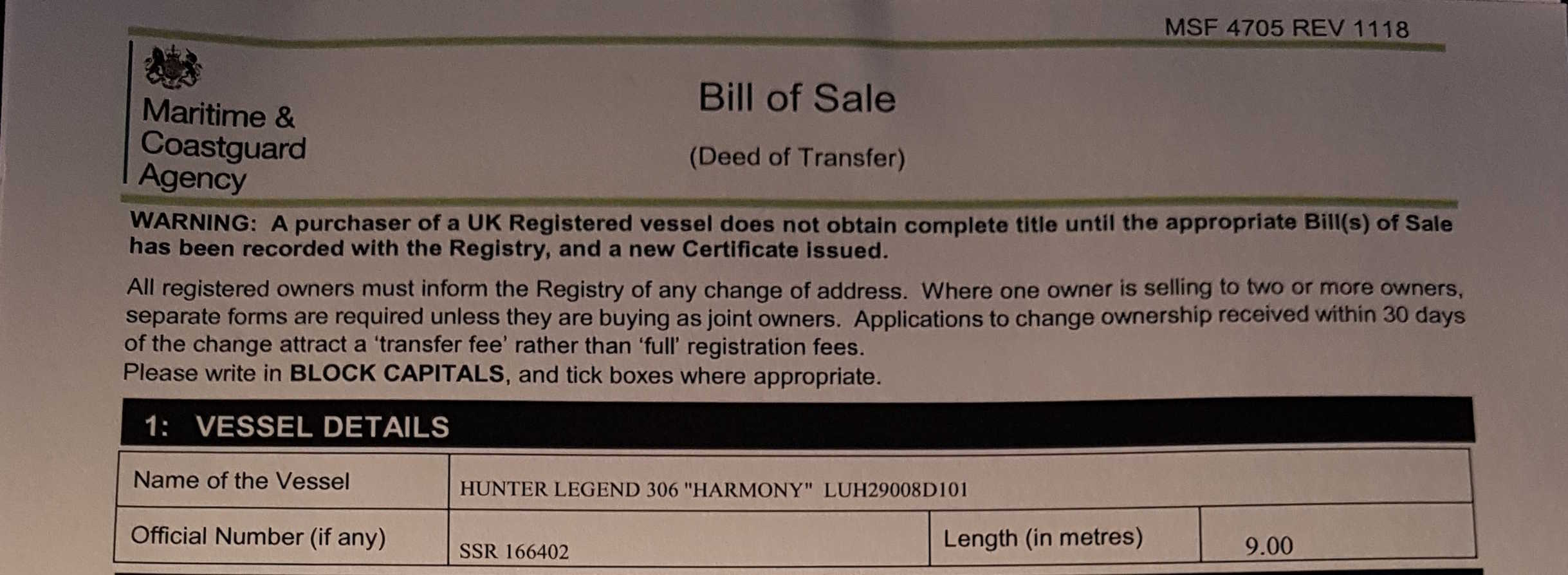
Yes, she's gone, gone, gone.
The day has come at last and I don't whether to laugh or cry. Harmony is sold.😢
On the one hand she was only getting yellower and weedier sitting there unused in North Shields, but on the other hand... well, we had some good times.
I dropped in again to finish emptying her the other day (don't ask!) and I was describing to my boat broker how intimately I knew the boat - even after all this time away, in the pitch dark I could still put my hand on any light switch. Boats have lots of small lights, and lots of small light switches. And I knew them all. Sigh.
Eventually it's going to be a weight off my mind - the berthing fees and the worry about damage every time there's bad weather. I had noticed, last time I visited, that one of her shore lines had almost worn through. (Good job I'd doubled them up 😉)
But until then, every time there's a fresh breeze early on a sunny morning I still keep thinking God, I miss sailing. I should get a boat!
While I was visiting I took some people, who turned out to be the new owners, out for a demonstration and we motored downriver and briefly got the sails up in the bay off South Shields at the mouth of the Tyne. So I did get a last sail on her after all. And the best of it was nothing broke, went wrong, or fell off. Bonus!
So Malcolm and Karen - I wish you all the best sailing. If Harmony brings you only a tenth of the joy I had you'll have struck a bargain!
As for me - perhaps one day I'll move back closer to the sea...
Old Salad Gazpacho Soup
soup salad veg vegan
I had made up a pretty reasonable green salad made from mandolined cabbage, red onion, carrots, chillies, green olives, cornichons,
and pimped out with chopped parsley, broccoli florets, capers and a drizzle of fine chardonnay vinegar.
Unfortunately I couldn't eat it because one of my teeth has decided to split, and until I get it extracted I can only drink.
Thank God for drink!
So, I turned the salad into a fluid by blending it up with some tomato juice, that I had spare from the Bloody Marys.
It does look a bit brown, but served with paprika, a few sour cream trails and drizzled with expensive olive oil it's really rather nice!
You can add pickled beetroot to redden it, but you do need quite a lot, which starts to affect the flavour.
I had another go at making two of these soups:
Thank God for drink!
So, I turned the salad into a fluid by blending it up with some tomato juice, that I had spare from the Bloody Marys.
It does look a bit brown, but served with paprika, a few sour cream trails and drizzled with expensive olive oil it's really rather nice!
You can add pickled beetroot to redden it, but you do need quite a lot, which starts to affect the flavour.
I had another go at making two of these soups:
- I blended one with fresh beetroot juice and a splash of balsamic or aged red wine vinegar. You certainly get a fantastic deep blood colour from the beetroot, but the dark musty flavour is a bit overwhelming. You need to avoid overdoing the juice, or cutting it with tomato juice or some other reddish liquid.
- To get a brighter green gazpacho I added spinach to the second blend and thinned it with Welch's White Grape Pear & Apple juice and a splash of chardonnay vinegar. That worked pretty well, though again it's easy to allow the spinach flavour to dominate.
Ingredients
- leftover salad
For colour:- fresh or pickled beetroot
- spinach
For liquid:- tomato juice
- beetroot juice
- apple, grape or pear juice. Or even apple, grape and pear juice!
For flavour:- balsamic vinegar
- aged red wine or chardonnay vinegar
- white wine
- Worcestershire sauce
- vodka
- cognac
Blend your salad until it's smooth, thinning with the liquid of your choice.
Flavour.
Season.
Serve with a drizzle of fine olive oil, a few torn herbs, a swirl of sour cream or a dollop of yoghurt. As you prefer.
Flavour.
Season.
Serve with a drizzle of fine olive oil, a few torn herbs, a swirl of sour cream or a dollop of yoghurt. As you prefer.
Almost makes me want to keep my split tooth. Almost.
Exotic Chicken and Rice
fowl main
Internet chef John
from Food Wishes dot Com has the weirdest lilting accent.
I'm not sure if I love it or hate it.
But I did enjoy his exotic chicken.
But I did enjoy his exotic chicken.
Serves 4
Ingredients
For the Exotic Marinade:- ⅓ cup plain yogurt
- 1 medium lime, zested and juiced
- 2 teaspoons kosher salt or less
- 1 teaspoon ground paprika
- 1 teaspoon ground cumin
- ½ teaspoon ground coriander or 1
- ¼ teaspoon cayenne pepper or chilli powder
- ¼ teaspoon ground white pepper
- ¼ teaspoon ground cardamom
- ¼ teaspoon ground cinnamon
- ¼ teaspoon ground allspice
- 1 (2 to 3 pound) whole chicken, cut into 8 pieces
For the Rice:- 1 pinch saffron or 1 tsp turmeric
- 2 ¼ cups chicken broth, divided
- 2 tablespoons unsalted butter
- 1 teaspoon kosher salt
- 1 ½ cups basmati rice
- 1 drizzle olive oil
- salt to taste
For the Garlic Yogurt Sauce (Optional*):- ½ cup plain yogurt
- 2 cloves garlic, crushed
- 2 tablespoons thinly sliced green onions
- 2 tablespoons finely chopped mint
- 2 tablespoons finely chopped cilantro
- salt to taste
- 1 tablespoon water, or as needed
Add yogurt, lime zest and juice, salt, paprika, cumin, coriander, cayenne, white pepper, cardamom, cinnamon, and allspice for marinade to a large mixing bowl;
whisk to combine.
Make one or two slits into each piece of dark chicken meat, down to the bone. Add chicken parts to the yogurt marinade and toss very thoroughly. Wrap in plastic wrap and marinate in the refrigerator for 4 to 8 hours.
Grind saffron in a mortar with a pestle. Pour in 1/4 cup chicken broth and stir to combine.
Roast in the center of the preheated oven until chicken is no longer pink in the centers and juices run clear, about 45 minutes. An instant-read thermometer inserted into the thickest part of the thigh, near the bone, should read 165°F (74°C).
While chicken is in the oven, mix yogurt, garlic, green onions, mint, cilantro, salt, and water (maybe a splash of chardonnay vinegar or lime juice too!) together for sauce. Reserve in the refrigerator until needed. Serve chicken and rice on a plate and top with sauce.
I reduced the salt to 1 teaspoon, increased the coriander to 1 tsp, and added ½ teaspoon of turmeric.
Make one or two slits into each piece of dark chicken meat, down to the bone. Add chicken parts to the yogurt marinade and toss very thoroughly. Wrap in plastic wrap and marinate in the refrigerator for 4 to 8 hours.
You can leave the chicken skin on or off, as you prefer. Or even used boned chicken parts.
Preheat the oven to 450°F/230°C/Gas Mark 8. Lightly grease a 9x13-inch casserole dish.Grind saffron in a mortar with a pestle. Pour in 1/4 cup chicken broth and stir to combine.
Or just substitute a teaspoon of turmeric for the colour.
Combine unsalted butter and salt in a saucepan; pour in remaining 2 cups chicken broth and chicken broth-saffron mixture. Bring to a boil over high heat.
Add basmati rice and stir to combine. Reduce heat to low, cover tightly, and let simmer gently for exactly 15 minutes; do not disturb while cooking.
Turn off the heat and let rest for 10 minutes.
Though this uses proportionally rather less water than I'm used to (1.5-to-1 rather than 2-to-1) it does work pretty well leaving the rice fairly firm for casseroling.
You need to turn the heat down very low though, and you still might get a little browning on the bottom.
Though 1½ cups of rice is just about right for 3 people, you might find you need more - say 2 cups rice and 3 cups of chicken stock. Which you made by boiling up the remains of the chicken carcass.
While the rice is still hot, transfer it into the prepared casserole dish. Use a fork to fluff the rice while gently spreading into an even layer.
Place the chicken pieces, skin-side up, on top of rice. Drizzle with olive oil and sprinkle with salt.
Though 1½ cups of rice is just about right for 3 people, you might find you need more - say 2 cups rice and 3 cups of chicken stock. Which you made by boiling up the remains of the chicken carcass.
Not sure about olive oil, which seems an odd flavour here.
Maybe vegetable oil, ghee or dot with butter?
Roast in the center of the preheated oven until chicken is no longer pink in the centers and juices run clear, about 45 minutes. An instant-read thermometer inserted into the thickest part of the thigh, near the bone, should read 165°F (74°C).
While chicken is in the oven, mix yogurt, garlic, green onions, mint, cilantro, salt, and water (maybe a splash of chardonnay vinegar or lime juice too!) together for sauce. Reserve in the refrigerator until needed. Serve chicken and rice on a plate and top with sauce.
Went down well. As far as one can tell with a grumpy child who mysteriously refuses to eat anything, but then sneaks back later and wolfs down the lot.
And even though I only used skinless chicken breasts, it really does take ¾ hour at Gas Mark 8! Which can turn the rice a little crunchy around the edges.
And even though I only used skinless chicken breasts, it really does take ¾ hour at Gas Mark 8! Which can turn the rice a little crunchy around the edges.
It goes well with broccoli florets browned, fried briefly with a turmeric/ginger/mustard powder paste, then dressed with grated creamed coconut.
* The sauce is not optional!
Oven Roast Sausages
DESCRIPTION
main breakfast meat
So if you're too lazy to fry your sausages,
don't own a frying pan, or can't be bothered because the Philistines you're cooking for can't tell the difference - you can roast your sausages in the oven.
Despite what some websites might have you believe they certainly won't manage it in 20 minutes at Gas Mark 4 though, so start them off at Gas Mark 5-6/190-200°C/380-400°F, allow 30 minutes, and don't overload the oven dish.
Give them a good greasing with dripping, lard or oil and turn them over every 10 minutes, so you can keep an eye on them. And for Christ's sake don't prick them!
The only real advantage oven-roasting has over pan-frying is that you can more successfully roast frozen sausages. It will take more like 45 minutes, at a slightly lower temperature, and you will need to keep turning them.
Despite what some websites might have you believe they certainly won't manage it in 20 minutes at Gas Mark 4 though, so start them off at Gas Mark 5-6/190-200°C/380-400°F, allow 30 minutes, and don't overload the oven dish.
Give them a good greasing with dripping, lard or oil and turn them over every 10 minutes, so you can keep an eye on them. And for Christ's sake don't prick them!
The only real advantage oven-roasting has over pan-frying is that you can more successfully roast frozen sausages. It will take more like 45 minutes, at a slightly lower temperature, and you will need to keep turning them.
COVID Springs Eternal

Spring is sprung, the grass is riz
I wonder where the boidies is
They say the boid is on the wing
But that's absoid, the wing is on the boid!
Ah, daffodil buds are finally appearing alongside the garbage-strewn road that leads to my nephew's school. In a good year they get the chance to blossom into flowers before the local school kids kick all their heads off.
In the movie of my life George Winston will provide the soundtrack to this time of year.
Though Spike Milligan made a good stab at lampooning the rainy season with recitals of his lovely pome. Well, not his. Author Unknown, apparently.
Over Easter I took time off to visit my yacht up in Newcastle, chase away the nesting seagulls and scrape off their Christmas presents.
Naturally it snowed. Welcome to Global Warming!
I spent the first couple of days aboard wallowing in the joy of Pringles after my Lentern abstention, and then buckled down to some overdue maintenance before clearing all my worldly possession out of the boat in preparation for selling her. Sigh 😢 Some of my worldly drinkables ended up in my tummy too.
Unfortunately, it turns out that all my worldly possessions won't fit into a moderately sized camper van, so Kurt and I will have to make a return trip in a few weeks to finish the job off. Meanwhile he's staunchly putting up with a large pile of some of my worldly possessions in the middle of his cellar floor.
When not on release from the Covid lockdown,
chez Sourville we spend a lot of our time bickering over the cooking, shopping, and whether or not we should all sit and gawp at the tellybox while we eat dinner.
I prefer the stimulation of conversation. But then, given where I'm living maybe I should just settle for the tellybox?
On the subject of shopping - I was forced, forced to order some rather nice Forvm wine vinegars which I can highly recommend from Melbury and Appleton (which definitely doesn't sound like a made up posh food company), due to the unusable ghastly supermarket horrors my brother bought us.
When you're on a high-salad diet, the quality of your dressings become depressingly important. But these matured vinegars definitely help.
And so, I've been doing healthy things with melons, and I finally managed to make a decent roast out of a topside beef joint, after years of trying, though it was not to everyone's taste 😉
Lastly, George's school has moved on from pushing Rice Krispies to pimping out Corn Flakes. Forcing me to adapt accordingly. Fortunately they haven't yet cut off my bagel supply - which is currently just about my only source of carbohydrates.
Those pounds don't lose themselves!
On the subject of shopping - I was forced, forced to order some rather nice Forvm wine vinegars which I can highly recommend from Melbury and Appleton (which definitely doesn't sound like a made up posh food company), due to the unusable ghastly supermarket horrors my brother bought us.
When you're on a high-salad diet, the quality of your dressings become depressingly important. But these matured vinegars definitely help.
And so, I've been doing healthy things with melons, and I finally managed to make a decent roast out of a topside beef joint, after years of trying, though it was not to everyone's taste 😉
Lastly, George's school has moved on from pushing Rice Krispies to pimping out Corn Flakes. Forcing me to adapt accordingly. Fortunately they haven't yet cut off my bagel supply - which is currently just about my only source of carbohydrates.
Those pounds don't lose themselves!
Slow-Roast Chicken with Fondant Potatoes
main staple fowl
This seemed like a fortuitous combination which requires surprisingly little supervision, for the most part.
Though I'm sure it's not quite the best way of roasting chicken, it may be the easiest.
It's basically this chicken roasting process with added potatoes.
Though I'm sure it's not quite the best way of roasting chicken, it may be the easiest.
It's basically this chicken roasting process with added potatoes.
Serves a Family
Ingredients
- 1 chicken
- butter
- garlic
- herbs
- ½ lemon
- potatoes
- chicken stock
Preheat the oven to Gas Mark 1.
Peel potatoes that aren't too floury and liable to fall apart. Cut them in half (lengthways or crossways - you decide) slice the opposite side flatter, then run a peeler or a small knife around the flat parts, turning them into vaguely barrel shapes, to remove the sharp edges that might burn. Put them in a bowl of water while you heat up a baking dish just large enough to hold them, half-filled with (ideally) chicken stock and flavoured with a few herbs and garlic cloves.
Mash up some butter, crushed garlic, salt, pepper and any herbs you like. Using a dessertspoon shove the mixture between the chicken breast and skin. Season the chicken cavity, fill with herbs of any description you fancy, and close with half a lemon.
Slice up some onions and layer them in the bottom of an oven tin. Put in the chicken, breast down, season, and smear over a little more butter. Surround the chicken with a few peeled carrots (cut lengthwise or into chunks if you prefer), a tablespoonful of liquid, loosely cover with foil and put in the middle of the oven.
Put the potatoes into the baking dish so the stock almost covers them, add a generous amount of butter (at least a couple of tablespoons), cover the dish lightly with foil, and put them in the top of the oven.
Now leave them for 2 hours.
After 2 hours, turn the oven up to Gas Mark 6.
Turn the potatoes over in the stock, uncover and return to the top shelf of the oven.
Turn the chicken breast-side up, smear with a little more butter and add a little liquid if required. Return, uncovered, to the middle of the oven.
You'll need to check on them occasionally now, but the chicken should be done after about 45 minutes, at which point you can take it out to rest before carving. At this point turn the potatoes, which by now should be roasting in pure fat and let the other side crisp up. Carve the chicken, strain the juices from the roasting tin and serve together with the potatoes and carrots.
Peel potatoes that aren't too floury and liable to fall apart. Cut them in half (lengthways or crossways - you decide) slice the opposite side flatter, then run a peeler or a small knife around the flat parts, turning them into vaguely barrel shapes, to remove the sharp edges that might burn. Put them in a bowl of water while you heat up a baking dish just large enough to hold them, half-filled with (ideally) chicken stock and flavoured with a few herbs and garlic cloves.
Mash up some butter, crushed garlic, salt, pepper and any herbs you like. Using a dessertspoon shove the mixture between the chicken breast and skin. Season the chicken cavity, fill with herbs of any description you fancy, and close with half a lemon.
Slice up some onions and layer them in the bottom of an oven tin. Put in the chicken, breast down, season, and smear over a little more butter. Surround the chicken with a few peeled carrots (cut lengthwise or into chunks if you prefer), a tablespoonful of liquid, loosely cover with foil and put in the middle of the oven.
Put the potatoes into the baking dish so the stock almost covers them, add a generous amount of butter (at least a couple of tablespoons), cover the dish lightly with foil, and put them in the top of the oven.
Now leave them for 2 hours.
After 2 hours, turn the oven up to Gas Mark 6.
Turn the potatoes over in the stock, uncover and return to the top shelf of the oven.
Turn the chicken breast-side up, smear with a little more butter and add a little liquid if required. Return, uncovered, to the middle of the oven.
You'll need to check on them occasionally now, but the chicken should be done after about 45 minutes, at which point you can take it out to rest before carving. At this point turn the potatoes, which by now should be roasting in pure fat and let the other side crisp up. Carve the chicken, strain the juices from the roasting tin and serve together with the potatoes and carrots.
The timing works pretty well, though you have to watch the potatoes pretty carefully towards the end if you want them crispy but not burned.
The chicken may take longer than advertised 😉
The chicken may take longer than advertised 😉
Cornflake Chicken
fowl main
Chicken covered with cornflakes and baked. Or are they corn flakes?
I followed Epicurious's transcription of the recipe. With added flour.
You could probably substitute Rice Krispies™ for the cornflakes.
The topping is crunchy. Though it also tastes distinctly of cornflakes.
I followed Epicurious's transcription of the recipe. With added flour.
You could probably substitute Rice Krispies™ for the cornflakes.
The topping is crunchy. Though it also tastes distinctly of cornflakes.
Serves 4
Ingredients
- a pound of chicken bits
- seasoned flour
- 1 egg
- a splash of milk
- a decent bowlful of cornflakes, crushed
Preheat the oven to Gas Mark 5-6/190-200°C.
Beat the egg with a splash of milk a couple of tablespoons will do in a bowl.
Put the cornflakes in a hole-free plastic bag and crush them up by running a rolling pin back and forth across the bag. They need to be reasonably fine, but not dust. Empty into a bowl.
Season a little flour in another bowl.
Thoroughly dry your chicken bits.
Bake for 30-40 minutes until cooked through.
Beat the egg with a splash of milk a couple of tablespoons will do in a bowl.
Put the cornflakes in a hole-free plastic bag and crush them up by running a rolling pin back and forth across the bag. They need to be reasonably fine, but not dust. Empty into a bowl.
Season a little flour in another bowl.
Thoroughly dry your chicken bits.
I used what my Local Fucking Supermarket™ calls chicken mini fillets.
Which are in fact just a collection of random skinned, boned, chicken bits.
I couldn't really get mine dry enough - hence the flour.
Roll each chicken bit in seasoned flour, shake off any excess, coat completely in the egg wash, shake of any excess, roll in the cornflakes to coat thoroughly,
then lay on a baking tray. Drizzle with oil or butter if you like.I couldn't really get mine dry enough - hence the flour.
Bake for 30-40 minutes until cooked through.
They're tasty enough, though a bit (ok, a lot) on the dry side. You'll need a dip or a sauce. Or a rich chicken gravy.
Serve with mash and some seriously good homemade coleslaw and pretend like you're at KFC.
Serve with mash and some seriously good homemade coleslaw and pretend like you're at KFC.
Seriously Good Homemade Coleslaw
salad veg
It's actually just a pretty run-of-the-mill coleslaw, but it does have the advantage of tasting pretty much like KFC's.
Well, as long as you don't add the celery seeds.
Perfect for budding little Philistines!
Perfect for budding little Philistines!
Serves 10
Ingredients
- 1 medium cabbage (about 2 pounds), outer leaves removed
- 3 medium carrots, peeled and shredded
- ½ cup loosely packed fresh parsley leaves, coarsely chopped
Dressing:- 1 cup (170 grams) mayonnaise
- 2 tablespoons apple cider vinegar or more to taste
- 2 tablespoons Dijon mustard or coarse ground mustard
- 1 teaspoon celery seeds
- ¼ teaspoon fine sea salt or more to taste
- ¼ teaspoon fresh ground black pepper or more to taste
- 1-2 teaspoons sugar optional
Quarter the cabbage through the core, and then cut out the core. Cut each quarter crosswise in half and finely shred.
Place the shredded cabbage in a very large bowl (you will have 6 to 8 cups).
Add the shredded carrot and parsley to the cabbage and toss to mix.
In a separate bowl, stir the mayonnaise, vinegar, mustard, celery seeds, salt, and pepper together. Taste for acidity and seasoning then adjust as desired. Add a little sugar too, if you like. Pour two-thirds of the dressing over the cabbage and carrot then mix well. (Clean hands are the quickest tool - as the actress said to the bishop!).
If the coleslaw seems dry, add a little more of the dressing. Eat right away or let it sit in the refrigerator for about an hour to let the flavors mingle and the cabbage to soften. The longer the cabbage sits in the coleslaw dressing, the softer and less crunchy it will become.
Add the shredded carrot and parsley to the cabbage and toss to mix.
In a separate bowl, stir the mayonnaise, vinegar, mustard, celery seeds, salt, and pepper together. Taste for acidity and seasoning then adjust as desired. Add a little sugar too, if you like. Pour two-thirds of the dressing over the cabbage and carrot then mix well. (Clean hands are the quickest tool - as the actress said to the bishop!).
If the coleslaw seems dry, add a little more of the dressing. Eat right away or let it sit in the refrigerator for about an hour to let the flavors mingle and the cabbage to soften. The longer the cabbage sits in the coleslaw dressing, the softer and less crunchy it will become.
If you left this in a giant bucket out in the hallway for a week, it would be indistinguishable from KFC's 😉
Slow Cooker Pork Chops in Tomato Sauce
main meat crockpot
Obviously you could add mushrooms, bacon, chorizo, etc. Even cream cheese!
Serves 6
Ingredients
- half a dozen pork chops
- olive oil for frying
- chilli flakes optional
- 1 onion, chopped
- 1 green pepper optional for pepper-averse Philistines, sliced
- tin chopped tomatoes
- 3-4 tablespoons tomato purée
- 1-2 tablespoons Worcestershire sauce
- concentrated chicken stock
- dried herbs Italian style - thyme, oregano, whatnot
- 4-6 garlic cloves, crushed
- salt & pepper
Sear the pork chops in small batches in a very hot frying pan with a little olive oil.
Add a pinch or two of dried chilli flakes, if you're in the mood.
Add the tomato purée and stir around the pan until any harsh aroma has cooked off and the oil begins to separate.
Thoroughly rinse out the pan with a little reduced stock and decant everything into the slow cooker.
Season, and cook on low for 8 hours or high for 4.
Serve over pasta with grated cheese.
Add the tomato purée and stir around the pan until any harsh aroma has cooked off and the oil begins to separate.
Thoroughly rinse out the pan with a little reduced stock and decant everything into the slow cooker.
Season, and cook on low for 8 hours or high for 4.
Serve over pasta with grated cheese.
The sauce is really tasty.
The chops, not so much. Tender yes, but rather dry I thought. You need to shred (or pull) them into the sauce to get any juice or flavour out of (into?) them.
The chops, not so much. Tender yes, but rather dry I thought. You need to shred (or pull) them into the sauce to get any juice or flavour out of (into?) them.
Sausage Braised with Brussels Sprouts and Caraway Seeds
main meat
You can make this with wedges of white cabbage instead of the sprouts.
In fact, it was just such a recipe which inspired me.
In fact, it was just such a recipe which inspired me.
Serves 3
Ingredients
- half a dozen pork sausages apple flavoured ones are nice
- oil, lard or dripping for frying
- butter for frying
- 1 onion, finely chopped
- a dozen brussels sprouts, trimmed, halved
- 1 teaspoon caraway seeds
- apple juice or cider
- chicken stock
- sour cream optional
Fry the sausages with a generous amount of fat over a moderate heat to brown them nicely. Set them aside.
Finely chop the onion and add to the pan and fry, gently, until starting to caramalize.
De-glaze the frying pan with apple juice or cider and chicken stock. Bubble to reduce about half, then add to the pot.
Stir the onion and sprouts and lay the sausages on top. Cover and put in a moderate Gas Mark 4 oven for 15-30 minutes or simmer for 15 minutes on the stove-top.
Stir through a couple of tablespoons of sour cream, if you like, and serve with some good German mustard and mashed potatoes.
You may want to discard the existing fat and start again with the onions, since those sausage juices do have a nasty tendency to burn.
Meanwhile heat a little oil and butter in an oven-proof pot if you plan on finishing this in the oven.
Press the sprouts into the pot, cut side down, and fry over high heat until they scorch a little.
Throw in the caraway seeds and the caramelized onions.De-glaze the frying pan with apple juice or cider and chicken stock. Bubble to reduce about half, then add to the pot.
Stir the onion and sprouts and lay the sausages on top. Cover and put in a moderate Gas Mark 4 oven for 15-30 minutes or simmer for 15 minutes on the stove-top.
Stir through a couple of tablespoons of sour cream, if you like, and serve with some good German mustard and mashed potatoes.
Rather tasty.
Excellent Roast Topside, Finally!
meat main
I've been fiddling around trying to reasonably roast topside and silverside joints by slower and slower cooking with more and more liquid
only to end up with increasingly stringy, dried-out, flavourless meat.
Sorry Flora!
And the solution was right there at Il Luogo di Aimo e Nadia in Milan all the time.
Just roast the joint at the highest temperature your oven will go until it's done.
Simples!
Well, of course, there's a bit of dry rubbing and resting and so on, but that's basically it. Despite the fact that the meat joint Fabio uses seems (as far as I can tell without actually speaking Italian) to be a piece of short loin, cut from the front or fattier end of the cow's back and including a section of tenderloin, his method produced my best topside joint yet with a lovely tasty crust and juicy succulent pink centre. You do have to slice it super-thinly to best experience it, and Philistines won't like the fact that it isn't brown and dry like the beef they're used to, doesn't taste like burned string vest or come apart like Shredded Wheat; but some sacrifices do have to be made for the Greater Steak.
Speaking of sacrifices, you'll struggle to prepare the usual accompaniments of roast potatoes or Yorkshire puddings in the blazing hot oven. You have half an hour while the meat rests to try and cook them, unless of course you live with the kind of Philistines who eat frozen roast potatoes (yup, they're a thing!) or frozen Yorkshires (also a thing), ready in mere minutes.
Simples!
Well, of course, there's a bit of dry rubbing and resting and so on, but that's basically it. Despite the fact that the meat joint Fabio uses seems (as far as I can tell without actually speaking Italian) to be a piece of short loin, cut from the front or fattier end of the cow's back and including a section of tenderloin, his method produced my best topside joint yet with a lovely tasty crust and juicy succulent pink centre. You do have to slice it super-thinly to best experience it, and Philistines won't like the fact that it isn't brown and dry like the beef they're used to, doesn't taste like burned string vest or come apart like Shredded Wheat; but some sacrifices do have to be made for the Greater Steak.
Speaking of sacrifices, you'll struggle to prepare the usual accompaniments of roast potatoes or Yorkshire puddings in the blazing hot oven. You have half an hour while the meat rests to try and cook them, unless of course you live with the kind of Philistines who eat frozen roast potatoes (yup, they're a thing!) or frozen Yorkshires (also a thing), ready in mere minutes.
Serves 4
Ingredients
- 1 kg topside beef joint
- 40g cane sugar
- 20g fine sea salt
- 2 teaspoons mustard powder
- a drizzle of olive oil
Bring the joint up to room temperature in good time for cooking. Tie loosely with butcher's twine to help it hold its shape while roasting.
Mix together 40% of the meat's weight in cane sugar and 20% in fine sea salt.
Contrary to Alssandro and Fabio's instructions I added a couple of teaspoons of English mustard powder. But then I am English.
Rub all over the joint, then set the joint on an oven rack to season for about 30 minutes.
You'll need to put it over a dish to catch the juices which will leak off as moisture is drawn from the meat.
Pre-heat the oven to 250°C/480°F/Gas Mark 9. Basically as hot as it will go.
Drizzle the joint with olive oil and place fat-side up on a rack over an oven tray. You should probably line the oven tray with foil for ease of cleaning.
My 1kg joint took exactly 45 minutes.
Set aside to rest for 30-35 minutes yes, really! turning occasionally to prevent the juices inside from all settling to one side. Though I very loosely covered mine with foil, the Italians recommend not doing so. However, they also seem not to mind cold meat.
Finally, cut away the string, slice the meat thinly and serve with your sauce of choice. Horseradish cream, mustard, salsa verde, chimichurri, gribiche, bearnaise sauce, or even gravy.
(Though you'll have to make the gravy separately - you won't get any gravy juices from this topside joint - they're all still inside. Or burned!)
Pre-heat the oven to 250°C/480°F/Gas Mark 9. Basically as hot as it will go.
Drizzle the joint with olive oil and place fat-side up on a rack over an oven tray. You should probably line the oven tray with foil for ease of cleaning.
I rather thought I might be able to use the juices caught in the tray to make up a gravy but all the drippings will just burn horribly.
And you don't want to add any liquid to the tray because that will interfere with the high-temperature roasting of the meat.
Put the joint in the centre or upper half of the oven and roast for something like 15 minutes, plus 15 minutes per pound.
Turn the joint occasionally and check the temperature towards the end. Remove from the oven when the centre reaches 48°C.My 1kg joint took exactly 45 minutes.
Set aside to rest for 30-35 minutes yes, really! turning occasionally to prevent the juices inside from all settling to one side. Though I very loosely covered mine with foil, the Italians recommend not doing so. However, they also seem not to mind cold meat.
Finally, cut away the string, slice the meat thinly and serve with your sauce of choice. Horseradish cream, mustard, salsa verde, chimichurri, gribiche, bearnaise sauce, or even gravy.
(Though you'll have to make the gravy separately - you won't get any gravy juices from this topside joint - they're all still inside. Or burned!)
Awesome!
Melon Mixed Salad
salad meat
Who knew that you could fuck up canning sweetcorn? Well, Morrisons supermarket does. Their own-label corn taste like unsweetened polystyrene.
So best avoided.
So best avoided.
Serves 4
Ingredients
- a couple of pickled beetroots, chopped
- ½ Galia melon, chopped
- 1 red onion, finely chopped
- bunch coriander, roughly chopped
- ⅔ tin sweetcorn Not Morrisons'!
- 150g ham, chopped
- 2 courgettes, chopped
- salad leaves
Dressing:- 2-3 anchovies, minced
- juice of 2 oranges
- juice of 1 lemon
- splash balsamic vinegar
- 100g grated parmesan
- 1-2 tablespoons mayonnaise
- glug olive oil
- dash Worcestershire sauce
- salt & pepper
- a little horseradish cream or perhaps mustard
Peel and deseed the melon, and the courgettes if you like.
Cut up the melon, beetroot, courgette and the ham into about 1cm cubes. Mix with the sweetcorn chopped red pepper and broccoli or cauliflower florets are also acceptable additions.
Mince or mash the anchovies and shake up with the citrus juice, vinegar and Worcestershire sauce.
Add as much finely grated parmesan as the mixture will reasonably absorb, then add a couple of tablespoons of mayonnaise and a glug of olive oil to thicken the mixture.
Spice it up with a little horseradish or mustard. If you like.
Serve the dressed salad over torn lettuce or rocket leaves.
Cut up the melon, beetroot, courgette and the ham into about 1cm cubes. Mix with the sweetcorn chopped red pepper and broccoli or cauliflower florets are also acceptable additions.
Mince or mash the anchovies and shake up with the citrus juice, vinegar and Worcestershire sauce.
Add as much finely grated parmesan as the mixture will reasonably absorb, then add a couple of tablespoons of mayonnaise and a glug of olive oil to thicken the mixture.
Spice it up with a little horseradish or mustard. If you like.
Serve the dressed salad over torn lettuce or rocket leaves.
Not too dusty. I was thinking of adding some feta cheese and black olives too. Maybe I should have?
Melon and Avocado Salad
salad veg
Not particularly original I suppose, but if you slice the melon and avocado similarly and rack them up next to each other they do look rather pretty 🙂
Serves 1 person per avocado
Ingredients
- firm orange/yellow melon, such as Galia, honeydew or a cantaloupe, sliced
- ripe avocado, sliced
- tomato
- coriander leaves, chopped
- bacon bits or ham - both optional
Dressings:- balsamic vinegar
- olive oil
Peel the melon and avocado and remove their seeds or stones.
Slice them both evenly into the same generous thickness.
Alternate the slices on serving plates, drizzle with olive oil and balsamic vinegar, scatter with chopped coriander leaves and bacon bits and serve with a decoratively cut tomato.
Alternate the slices on serving plates, drizzle with olive oil and balsamic vinegar, scatter with chopped coriander leaves and bacon bits and serve with a decoratively cut tomato.
Pretty and delicious!
Two and a Half Men

Welcome to 2021!
Honestly it's just like a sitcom here - two brothers doing their best to bring up a young boy in trying circumstances. I should write a book!
But It's going to be a slim month or two on the cooking front, now that I'm now doing my best to lose some winter OK, and the rest... pounds by indulging in my patented raw food diet. Plus crisps. Which are a kind of raw food too, right?
While it makes meal times a good deal less interesting, it does make them easier, since the Philistines are perfectly happy eating plain boiled vegetables and something from the freezer baked in the oven. Which leaves me more time for chopping lettuce.
On the subject of vegetable boiling, though more for my benefit than yours 🤟😝👆, here are my timings for the daily churn of producing vegetables not too crisp and not too soggy on my gas stove:
- Bring your pot of minimally watered vegetables to the boil:
- 5 minutes allowance for bringing the pot back to the boil over a low heat after adding boiling water.
- 20 minutes allowance for bringing the pot to the boil from cold on a low heat.
- Cook the veggies:
- 5-10 minutes simmering for soft or small diced vegetables (broccoli, cauliflower, sliced carrots...)
- 15 minutes simmering for chunked hardier or root vegetables (potatoes, turnip, swede...)
- 20 minutes simmering for cooking chunked veggies ready for mashing or roasting.
- 5 minutes allowance after cooking for draining, drying, greasing, mashing, etc.
- Finally, for long-cooked soft leafy vegetables like broccoli or sprouts (or carrots) not for Philistines: cook on a very low heat for 30 minutes from adding a little boiling water, as well as a pinch of sugar, bicarbonate of soda and some fat or oil.
Blue Cheese & Chicken Salad
salad fowl cheese
A sort of over-complicated caesar-y chicken salad.
Ingredients
- chicken, diced
- anchovies, minced
- sweet gem lettuce, sliced across fatly
- blue cheese, crumbled
- red pepper, diced
- cucumber, diced
- sweetcorn
- celery, diced possibly
- red onion, chopped
- avocado, cubed
- lemon juice or white wine vinegar
Dressing:- mayonnaise
- olive oil from the anchovies, preferably
- white wine vinegar
- parmesan unless that's cheesy overkill?
- soy sauce optional
- garlic maybe
First roast your chicken 😉
Halve the avocado, remove the stone, scoop the flesh from the skin with a spoon and cut into smallish cubes. Drizzle with a little lemon juice or white wine vinegar to slow down the browning process enough to be able to serve it still green.
Shred the chicken.
Mince the anchovies.
Cut the sweet gem lettuce leaves in half lengthways, then cut into fat slices.
Drain the sweetcorn.
Core, seed and dice the red pepper.
Cube the cucumber.
Chop the red onion.
Dice the celery small it would be the first thing I'd leave out.
Mix everything together then crumble over blue cheese.
Make up a dressing from mayonnaise, some of the anchovy olive oil (they used only the finest quality oil right?) and vinegar.
If you want to keep the dressing white for the aesthetics then you'll have to use white wine vinegar. But if you aren't so fussy a splash of soy sauce and balsamic vinegar goes down quite well.
You can add in some grated parmesan too, if you like. At least that's white.
Season with salt and, if you like, white pepper.
Halve the avocado, remove the stone, scoop the flesh from the skin with a spoon and cut into smallish cubes. Drizzle with a little lemon juice or white wine vinegar to slow down the browning process enough to be able to serve it still green.
Shred the chicken.
Mince the anchovies.
Cut the sweet gem lettuce leaves in half lengthways, then cut into fat slices.
Drain the sweetcorn.
Core, seed and dice the red pepper.
Cube the cucumber.
Chop the red onion.
Dice the celery small it would be the first thing I'd leave out.
Mix everything together then crumble over blue cheese.
Make up a dressing from mayonnaise, some of the anchovy olive oil (they used only the finest quality oil right?) and vinegar.
If you want to keep the dressing white for the aesthetics then you'll have to use white wine vinegar. But if you aren't so fussy a splash of soy sauce and balsamic vinegar goes down quite well.
You can add in some grated parmesan too, if you like. At least that's white.
Season with salt and, if you like, white pepper.
Rather good. You might crush some garlic into the dressing too.
Slow Cooked Chicken Casserole
fowl main crockpot
A chicken casserole done in the slow cooker. Pretty good if I say so myself ;)
Serves 8
Ingredients
- 1kg/8 chicken thighs, skinned, boned
- 6 slices bacon or 50g chorizo - if your brother hasn't used it all up
- 3 carrots
- 300g or a dozen or so brussels sprouts
- 3 potatoes
- 2 red onions
- 6 garlic cloves
- olive oil for frying
- 1 tbsp tomato purée
- 250ml chicken stock
- 1 tin baked beans
- 1 tin chopped tomatoes
- 1 tbsp or so soy sauce
- handful olives
- 1 tbsp capers
- 1 tbsp paprika
- 2 bay leaves
- a few sprigs thyme
- oregano
- pepper
- salt
Peel and chop the root vegetables into fat chunks.
Remove any damaged outer leaves from the sprouts and trim their stems.
Put them all in the slow cooker.
Feel free to add any chunked broccoli or cauliflower stalks you might have hanging around too (after trimming away any stringy parts). And some celery.
Roughly chop the onions (or cut them into segments). Heat olive oil in a large frying pan and fry the onion until they begin to colour around the edges then add to the slow cooker.
Chop the bacon or the chorizo into pieces or matchsticks. Peel the garlic and cut up any larger cloves. Fry the bacon and the garlic until the bacon is crisping and the garlic begins to colour.
Add everything to the slow cooker.
Cut up the chicken thighs if you like I didn't, but then mine were still partly frozen!. Coat with a little olive oil and dress with ground black pepper and some of the paprika and seasoned flour too - if you like. Add more oil to the frying pan if necessary and fry the chicken pieces until they are lightly browned all over.
Add to the slow cooker.
Add the tomato purée to the frying pan and cook a little then empty in the tinned tomatoes and simmer until thickened and reduced.
Add to the slow cooker.
Pour the stock into the frying pan and simmer until well reduced.
Add to the slow cooker.
Add the tin of beans, the olives, capers, bay leaves, the soy sauce, the rest of the paprika and any herbs you like fresh or dried thyme and oregano leaves. Season, and add more stock if necessary - though there should be barely any liquid in there.
Turn the slow cooker on low for 8-9 hours or high for 4 hours, with maybe a stir about half way through.
Serve with mash and, if you can figure out how to manage it in a slow cooker, dumplings.
Put them all in the slow cooker.
Feel free to add any chunked broccoli or cauliflower stalks you might have hanging around too (after trimming away any stringy parts). And some celery.
Roughly chop the onions (or cut them into segments). Heat olive oil in a large frying pan and fry the onion until they begin to colour around the edges then add to the slow cooker.
Chop the bacon or the chorizo into pieces or matchsticks. Peel the garlic and cut up any larger cloves. Fry the bacon and the garlic until the bacon is crisping and the garlic begins to colour.
Add everything to the slow cooker.
Cut up the chicken thighs if you like I didn't, but then mine were still partly frozen!. Coat with a little olive oil and dress with ground black pepper and some of the paprika and seasoned flour too - if you like. Add more oil to the frying pan if necessary and fry the chicken pieces until they are lightly browned all over.
Add to the slow cooker.
Add the tomato purée to the frying pan and cook a little then empty in the tinned tomatoes and simmer until thickened and reduced.
Add to the slow cooker.
Pour the stock into the frying pan and simmer until well reduced.
Add to the slow cooker.
Add the tin of beans, the olives, capers, bay leaves, the soy sauce, the rest of the paprika and any herbs you like fresh or dried thyme and oregano leaves. Season, and add more stock if necessary - though there should be barely any liquid in there.
Turn the slow cooker on low for 8-9 hours or high for 4 hours, with maybe a stir about half way through.
Serve with mash and, if you can figure out how to manage it in a slow cooker, dumplings.
Rather good.
You might want to fry a little flour added at the beginning or stir in a little cornflour at the end to thicken it up. Definitely don't add too much liquid.
You might want to fry a little flour added at the beginning or stir in a little cornflour at the end to thicken it up. Definitely don't add too much liquid.
Concerning dumplings; Contrary to everything you might assume from
every
single
instructional
on the inter-webs telling you they'll be ready in 30 minutes, trying to cook dumplings in your slow cooker will make you cry.
I had my dumplings (golf-ball-sized)
cooking, on top of the stew, on high, for 2 hours
and they still weren't cooked.
I even tried covering the pot with cling film to keep in the heat.
You might do better if you make them barely the size of marbles, but I doubt it.
You might do better if you make them barely the size of marbles, but I doubt it.
Furthermore, 3½ hours for smallish parsley dumplings is a bit too long - if it's possible to overcook dumplings, these were overcooked.
It would seem the sweet spot is somewhere between 2 and 3 hours.
Slow Cooked Beef Stew
main meat crockpot
Here's what I put in mine, but some celery wouldn't have gone amiss. And I'd have put in some bacon too, if I'd remembered.
Probably a splash or two of soy sauce would help deepen the flavour.
The pâté was something I needed to use up and this seemed a good way to do it. It definitely enriches the stew.
Probably a splash or two of soy sauce would help deepen the flavour.
The pâté was something I needed to use up and this seemed a good way to do it. It definitely enriches the stew.
Serves 4-6
Ingredients
- 750g beef, cubed
- seasoned flour
- 2" ginger, minced
- 2 onions, chopped
- 4 garlic cloves, chopped
- 2 tblsps tomato purée
- ½ swede, chunked
- 2 carrots, chunked
- 2 potatoes, chunked
- 100g Brussels pâté
- stock
- half a bottle of beer or lager
- 2 bay leaves
- 2 tblsps paprika
- 1-2 tsps dried thyme
- 1-2 tsps dried rosemary
- splash Worcestershire sauce
To Grind:- 1 tsp red peppercorns
- 1 tsp black peppercorns
- 1 tsp caraway seeds
- 1 tsp brown mustard seeds
- 10g dried porcini mushrooms
- salt
Garnish:- parsley, chopped
Heat a puddle of oil in a frying pan. Shake the beef cubes in a bag with the seasoned flour and fry quickly in batches over high heat, turning until they're nicely coloured.
Add to the slow cooker.
Fry the ginger over medium heat until it begins to caramelize, then add the onions and fry until they too begin to brown, then add the garlic and fry for a few more minutes. Stir through the tomato purée and cook until it loses its harsh flavour then tip everything into the slow cooker.
Clean the frying pan out with the beer, reducing it by about half, then add to the slow cooker. Mash the pâté into a little of the stock pressing it through a sieve if it remains persistently lumpy. Add to the slow cooker.
Trim away the outer leaves of the sprouts and roughly chunk the vegetables. No need to peel the potatoes or the carrots, if they're clean. Fill the slow cooker with them, throwing in a couple of bay leaves and the dried herbs. Pour in enough stock to barely cover and add a splash or two of Worcestershire sauce and maybe some soy sauce.
Grind up the spices and the dried mushrooms an electric grinder is ideal with a little sea salt.
Add the paprika and sprinkle over the stew.
Add to the slow cooker.
Fry the ginger over medium heat until it begins to caramelize, then add the onions and fry until they too begin to brown, then add the garlic and fry for a few more minutes. Stir through the tomato purée and cook until it loses its harsh flavour then tip everything into the slow cooker.
Clean the frying pan out with the beer, reducing it by about half, then add to the slow cooker. Mash the pâté into a little of the stock pressing it through a sieve if it remains persistently lumpy. Add to the slow cooker.
Trim away the outer leaves of the sprouts and roughly chunk the vegetables. No need to peel the potatoes or the carrots, if they're clean. Fill the slow cooker with them, throwing in a couple of bay leaves and the dried herbs. Pour in enough stock to barely cover and add a splash or two of Worcestershire sauce and maybe some soy sauce.
Grind up the spices and the dried mushrooms an electric grinder is ideal with a little sea salt.
Add the paprika and sprinkle over the stew.
Ground dried mushrooms are a great way of flavouring stews if you're cooking for fussy eaters who don't like the squeaky texture of whole mushrooms.
Plus a little goes a very long way.
Chop up the parsley and keep it for a garnish (though you can throw the chopped stalks into the stew too).
Not too dusty 😉
Fondant Potatoes
staple side
This time I took the opposite approach to fondanting my potatoes
- frying them in butter first, then finishing them off with stock in the oven.
I had a slow-cooking pork joint in at Gas Mark 3, so I sat the potatoes in the covered frying pan on the top shelf for an hour which seemed about perfect.
If you were cooking them on the stove-top it would probably only take half the time. I reckon they probably do taste better boiled first then finished in the butter, but this method was pretty low maintenance. You don't get that crunchy finish, but the potatoes are meltingly soft and well flavoured.
You can halve the potatoes lengthwise or crosswise, as I did here, to get two more equal flat sides. Take your pick.
I had a slow-cooking pork joint in at Gas Mark 3, so I sat the potatoes in the covered frying pan on the top shelf for an hour which seemed about perfect.
If you were cooking them on the stove-top it would probably only take half the time. I reckon they probably do taste better boiled first then finished in the butter, but this method was pretty low maintenance. You don't get that crunchy finish, but the potatoes are meltingly soft and well flavoured.
You can halve the potatoes lengthwise or crosswise, as I did here, to get two more equal flat sides. Take your pick.
Serves 4
Ingredients
- 4-6 potatoes
- 2-3 cloves garlic, slightly smashed
- 2 or 3 of sprigs of rosemary and thyme
- 5oz (150g) butter
- 3 fl oz (75ml) chicken stock
- sea salt & pepper
Peel the potatoes, halve them and pare the opposite sides down flat.
Carefully add the stock and season well.
Cover and simmer gently for about half an hour until the potatoes are tender. Or put them in a 160°C/325°C/Gas Mark 3 oven for an hour, or a 200°C/400°F/Gas Mark 6 oven for about half an hour.
Keep warm before serving.
If you soak them for half an hour you'll remove the excess starch and help with the browning. Dry them thoroughly afterwards.
Melt most the butter in a saucepan over a medium heat until it starts to foam.
Place the potatoes in the pan and cook for about 5-6 minutes until they're golden on the bottom.
Then turn them over, add the garlic and herbs and the rest of the butter and cook for the same time again.Carefully add the stock and season well.
Cover and simmer gently for about half an hour until the potatoes are tender. Or put them in a 160°C/325°C/Gas Mark 3 oven for an hour, or a 200°C/400°F/Gas Mark 6 oven for about half an hour.
Keep warm before serving.
Slow Cooker Beef Curry
curry meat main crockpot
This turned out to be an excellent training curry for a young Philistine, though the elder Philistine did complain it was not as spicy as the aroma had led him to believe.
I slightly enhanced Lulu Grimes slow cooker recipe by the addition of fruit. And, of course, more spices.
I slightly enhanced Lulu Grimes slow cooker recipe by the addition of fruit. And, of course, more spices.
Serves 4
Ingredients
- 750g beef for braising (braising steak, chuck, flank etc) cut into chunks
- seasoned flour for coating
- 4-6 small potatoes, halved or cut into fat chunks
- 3 tbsp oil
- 1 onion, chopped
- 4 garlic cloves, crushed
- 5cm piece ginger, grated or 1½ tsps ginger powder
- 4 cardamom pods
- 1 cinnamon stick
- couple bay leaves
- a pinch of crushed dried chillies
- 1-2 tsp smoked paprika
- 2 tsps ground coriander
- 1½ tsps ground cumin
- 1 tsp fenugreek powder
- 1 teaspoon garam masala
- 1 tsp ground turmeric
- ½-1 tsp chilli powder
- 400ml coconut milk
- tablespoon or two mango pickle
- 1 mango, peeled, chopped
To Serve:- small bunch coriander, chopped
Heat your slow cooker if you need to.
Mix the powdered spices with a little water to make a paste.
Cut the beef into chunks and halve the potatoes or cut them up into hefty chunks no need to peel them.
Crush the garlic, grate the ginger and roughly chop the onion.
Heat a couple of tablespoons of oil or ghee and add the cinnamon and cardamom pods. I forgot the cardamom pods. Didn't seem to do the curry any harm. Fry until they sizzle and release their fragrance. Add a pinch of crushed chillies to taste.
Coat the beef pieces generously in seasoned flour and fry in batches in the oil until browned all over and tip into the slow cooker with the raw potatoes.
Re-oil the frying pan and fry the onion over a low heat until it starts to soften. Add the garlic and ginger and fry for 1 minute.
Add the spice paste and fry for 1 minute or until the spices start to smell fragrant. Add the coconut milk and bring to a simmer, then tip everything into the slow cooker.
Cook for 4 hours on high or 8 hours on low. Peel the mango and cut into cubes. Add to the pot with 2 hours to go. You can throw in the stone too, from which you won't quite be able to cut away all the flesh. Don't try to eat it though 😉
When ready, dress with coriander and serve.
Mix the powdered spices with a little water to make a paste.
Cut the beef into chunks and halve the potatoes or cut them up into hefty chunks no need to peel them.
Crush the garlic, grate the ginger and roughly chop the onion.
Heat a couple of tablespoons of oil or ghee and add the cinnamon and cardamom pods. I forgot the cardamom pods. Didn't seem to do the curry any harm. Fry until they sizzle and release their fragrance. Add a pinch of crushed chillies to taste.
Coat the beef pieces generously in seasoned flour and fry in batches in the oil until browned all over and tip into the slow cooker with the raw potatoes.
Re-oil the frying pan and fry the onion over a low heat until it starts to soften. Add the garlic and ginger and fry for 1 minute.
Having no fresh ginger I added 1½ tsps ginger powder to the other spices.
Add the spice paste and fry for 1 minute or until the spices start to smell fragrant. Add the coconut milk and bring to a simmer, then tip everything into the slow cooker.
I used a very thick, high quality coconut milk, so I cleaned the frying pan out with stock, reduced it, and added that too.
Cook for 4 hours on high or 8 hours on low. Peel the mango and cut into cubes. Add to the pot with 2 hours to go. You can throw in the stone too, from which you won't quite be able to cut away all the flesh. Don't try to eat it though 😉
When ready, dress with coriander and serve.
Delicious!
Methi Matar Malai
Creamy Peas and Fenugreek Leaf Curry
Creamy Peas and Fenugreek Leaf Curry
veg curry side
I was going to attribute this to Srividhya's post,
but her website is so full of gibbering spam as to be unusable. So I won't.
I had no poppy seeds, no fresh ginger (for which I substituted ½ tsp ginger powder), no chillies (this was cooked for softies) and no fresh fenugreek, so I used dried.
You might need 50g/2 cups of fresh leaves. If you can find them.
I had no poppy seeds, no fresh ginger (for which I substituted ½ tsp ginger powder), no chillies (this was cooked for softies) and no fresh fenugreek, so I used dried.
You might need 50g/2 cups of fresh leaves. If you can find them.
Serves 4
Ingredients
To Soak:- a handful of cashews, chopped or broken
- 2 tsp poppy seeds
- ½ cup of water or milk or watery milk
To Cook:- oil for frying
- 4 cardamom
- 4 cloves
- stick cassia
- 1 onion, chopped
- 2 green chilies broken into two
- 2-3 cloves garlic, chopped
- ½ piece of ginger, grated or minced or ½ tsp ginger powder
- 1 tsp salt or to taste
- couple tablespoons dried fenugreek leaves or 50g/2 cups tightly packed fenugreek leaves.
- 1 cup frozen peas
- 3/4 cup water divided
- ⅓ cup heavy cream refer notes
To Garnish:- ½ tsp garam masala
- chopped coriander
- juice of ½ lemon
Strip the fenugreek leaves from their stems, rinse thoroughly and chop roughly.
Soak the poppy seeds if you have any and broken cashews in ½ cup of water/milk for 30 minutes.
Meanwhile heat a little oil in a frying pan fry the whole spices until they sizzle and release their aroma. Then add the onions and green chillies if using and fry for about 10 minutes until soft and light brown around the edges. Add the garlic and the fresh ginger and fry a little more until the oil separates and the harsh aroma is cooked off.
Allow to cool slightly then tip into a blender along with the soaked nuts.
Heat more oil or ghee in the frying pan and sauté the paste briefly until the oil separates and any harsh aroma has cooked off add the ginger powder now if using.
Add about ¼ cup water with some salt and cook, stirring regularly, for 5-10 minutes until the sauce thickens then add the fenugreek leaves fresh or dry and cook for another 5 minutes.
Add the peas as many as you like really and warm through gently.
Serve with a sprinkle of garam masala, some chopped coriander or a squeeze of lemon juice.
Soak the poppy seeds if you have any and broken cashews in ½ cup of water/milk for 30 minutes.
Meanwhile heat a little oil in a frying pan fry the whole spices until they sizzle and release their aroma. Then add the onions and green chillies if using and fry for about 10 minutes until soft and light brown around the edges. Add the garlic and the fresh ginger and fry a little more until the oil separates and the harsh aroma is cooked off.
Allow to cool slightly then tip into a blender along with the soaked nuts.
You can remove the whole spices if you like, or leave them in as long as you blend them all up very smoothly.
Heat more oil or ghee in the frying pan and sauté the paste briefly until the oil separates and any harsh aroma has cooked off add the ginger powder now if using.
Add about ¼ cup water with some salt and cook, stirring regularly, for 5-10 minutes until the sauce thickens then add the fenugreek leaves fresh or dry and cook for another 5 minutes.
Add the peas as many as you like really and warm through gently.
You can pre-warm frozen peas in a pot of boiling water, if you like.
If you want to use fresh peas you should probably cook them a little first to soften them up.
Finally, add the cream, stir and simmer on a low heat for a couple of minutes.Serve with a sprinkle of garam masala, some chopped coriander or a squeeze of lemon juice.
Really quite good, to say I had only half the necessary ingredients!
Add a little sugar if you find the fenugreek too bitter.
Add a little sugar if you find the fenugreek too bitter.
Kookoo
Persian Omelette
Persian Omelette
starter side veg main
A sort of Iranian omelette eaten hot or cold as a starter or a side dish, or a vegetarian main.
Went down like a Persian balloon P.b. Pb. Lead. Geddit? Oh well, please yourselves....
Suffice to say, no-one went cuckoo for Kookoo 🙁
Went down like a Persian balloon P.b. Pb. Lead. Geddit? Oh well, please yourselves....
Suffice to say, no-one went cuckoo for Kookoo 🙁
Serves 8
Ingredients
- 1 large cauliflower
- 2 medium onions
- Oil for frying
- 2 tsp turmeric
- 120g parsley
- 3 dessertspoons plain flour
- salt
- 1½ tsp baking powder
- 10 medium eggs
Accompaniment:- Pickles and fresh herbs
Wash the cauliflower and cook in salted water. Mash and leave to cool.
Chop the onions and fry in a little oil until soft and golden. Stir in the turmeric and put aside to cool.
Wash and chop the parsley you might consider coriander instead?. When all the ingredients are cool, mix the cauliflower, flour, baking powder, onions and parsley.
Heat enough oil to cover the base of a large frying pan. While the oil heats, beat the eggs until frothy, then stir in the cauliflower mixture. Pour into the hot oil, then immediately reduce the heat, cover and cook over a gentle heat for 25 minutes until firm.
Turn over and cook for a further 10 minutes. Serve immediately with mixed pickles and fresh herbs.
Chop the onions and fry in a little oil until soft and golden. Stir in the turmeric and put aside to cool.
Wash and chop the parsley you might consider coriander instead?. When all the ingredients are cool, mix the cauliflower, flour, baking powder, onions and parsley.
And salt. This really needs some salt!
Heat enough oil to cover the base of a large frying pan. While the oil heats, beat the eggs until frothy, then stir in the cauliflower mixture. Pour into the hot oil, then immediately reduce the heat, cover and cook over a gentle heat for 25 minutes until firm.
Turn over and cook for a further 10 minutes. Serve immediately with mixed pickles and fresh herbs.
I rather liked it - surprisingly fluffy and airy. I did add some mayonnaise and piccalilli juice too. Which might have helped to put off the Philistines.
Steak and Blue Cheese Pie
main meat cheese
Stilton, would be the traditional blue cheese of choice, though I used Cambazola - a mild blue cheese suitable for curdophobic Philistines.
It's best to start this pie a day or two ahead with a bag of well-fatted beef bones. Which you will boil up for a couple of hours with diverse herbs and alliums. You can then skim off the thick layer of dripping with which to make your pastry, and reduce the stock almost to demi-glaze to make the sauce. Yum!
My experience is that if you have a really good, well-reduced stock you shouldn't use too much (or any?) flour to coat the meat since the sauce may turn out unnecessarily gloopy. If you otherwise have only thin gruel, then gloopy is probably your best hope.
It's best to start this pie a day or two ahead with a bag of well-fatted beef bones. Which you will boil up for a couple of hours with diverse herbs and alliums. You can then skim off the thick layer of dripping with which to make your pastry, and reduce the stock almost to demi-glaze to make the sauce. Yum!
My experience is that if you have a really good, well-reduced stock you shouldn't use too much (or any?) flour to coat the meat since the sauce may turn out unnecessarily gloopy. If you otherwise have only thin gruel, then gloopy is probably your best hope.
Serves 6
Ingredients
For the Pastry:- 400g plain flour
- 2 tsps English mustard powder
- 200g dripping and butter
- ½ teaspoon salt
- 2 egg yolks
- ice water
For the Filling:- 1kg steak, cubed
- 2 tsps English mustard powder
- seasoned flour
- olive oil for frying
- 1½-2 red onions, chopped
- half a dozen cloves garlic, chopped
- 150g button mushrooms
- 100g blue cheese, crumbled or cubed, if it won't crumble
- strong beef stock
- 1 tblsp Worcestershire sauce
- 2 tblsps soy sauce
- handful thyme leaves
- couple of bay leaves
- ½ bottle pale ale you can drink the rest!
Make the Pastry
Cut the well-chilled fat into 1cm cubes. Dripping (or lard) is good for pastry crispness since it doesn't melt until cooked leaving a nice pastry honeycomb structure behind, but butter is good for flavour. So a mixture of the two is ideal. Add the mustard powder and salt into the flour then cut in the fat without overworking the mixture, or letting it get too warm. You don't need to rub away all the fatty chunks.
Cut in ice cold water until the mixture just clumps up. Roll into two flattened balls (one twice as large as the other), wrap in clingfilm and chill in the fridge for half an hour or so.
Set aside to cool.
Make the Filling
Cut the steak braising steak will do into 1" chunks and roll them in flour seasoned with salt and pepper and mixed with a few teaspoons of English mustard powder. Place a layer not too closely spaced in a hot frying pan with a generous amount of oil and leave to fry until they develop a nice bottom crust, then flip and caramelise the other side. Brown in batches, as necessary and set aside.
Add the chopped onion and more oil if required and fry gently until beginning to brown at the edges. Stir through chopped garlic and fry a little. Pour in a glass or two of pale ale and simmer until it bubbles and reduces a little, then add back the steak, cover with beef stock, add herbs, a dash or two of soy and Worcestershire sauce and simmer gently for a 2-3 hours or until the meat is tender. Or you can casserole it in the oven for a few hours. Meanwhile clean and fry the button mushrooms in butter until they take on a little colour. Add to the stew some half hour before it's ready. Reduce the sauce at the end until it is nice and thick. Now you can season it.
Leave to cool.
Fill the Pie
Fill the cooled pastry casing with the cooled filling. Crumble the blue cheese over the top.
Roll out the chilled ball of dough for the pie lid and cover the pie, crimping closed around the edges. Trim, decorate with left-over pastry pieces and make a couple of slits in the crust so it doesn't explode ;)
Chill thoroughly in the fridge or even freeze before cooking.
Preheat the oven to Gas Mark 4-5 and bake the chilled pie for 1-1½ hours until the crust is golden and the filling pie-ping hot (geddit?). Adjust temperatures accordingly in the process.
Cut the well-chilled fat into 1cm cubes. Dripping (or lard) is good for pastry crispness since it doesn't melt until cooked leaving a nice pastry honeycomb structure behind, but butter is good for flavour. So a mixture of the two is ideal. Add the mustard powder and salt into the flour then cut in the fat without overworking the mixture, or letting it get too warm. You don't need to rub away all the fatty chunks.
Cut in ice cold water until the mixture just clumps up. Roll into two flattened balls (one twice as large as the other), wrap in clingfilm and chill in the fridge for half an hour or so.
If you like, for added richness, you can mix an egg yolk or two into the water.
It's probably not really worth it for a strongly flavoured pied crust like this one though.
You can also add chopped herbs to the mixture.
Dust your chilled marble slab with flour and working quickly roll out the larger ball,
lift (rolled around your pin if necessary) and drop into your pie dish, gently pressing the pastry into the bottom.
Cover the pastry with foil, fill with baking beans or sugar and bake blind at Gas Mark 5-6 for about 15 minutes or until the pastry becomes firm around the edges,
then remove the beans and the foil and return to the oven on a lower shelf to finish off for 5-10 minutes until all the pastry is a light tan colour.
If you like you can paint the inside with beaten egg white to seal the surface.
Don't let the egg white pool though, or you'll end up with some unpleasantly rubbery sheets in the bottom.Set aside to cool.
Make the Filling
Cut the steak braising steak will do into 1" chunks and roll them in flour seasoned with salt and pepper and mixed with a few teaspoons of English mustard powder. Place a layer not too closely spaced in a hot frying pan with a generous amount of oil and leave to fry until they develop a nice bottom crust, then flip and caramelise the other side. Brown in batches, as necessary and set aside.
Add the chopped onion and more oil if required and fry gently until beginning to brown at the edges. Stir through chopped garlic and fry a little. Pour in a glass or two of pale ale and simmer until it bubbles and reduces a little, then add back the steak, cover with beef stock, add herbs, a dash or two of soy and Worcestershire sauce and simmer gently for a 2-3 hours or until the meat is tender. Or you can casserole it in the oven for a few hours. Meanwhile clean and fry the button mushrooms in butter until they take on a little colour. Add to the stew some half hour before it's ready. Reduce the sauce at the end until it is nice and thick. Now you can season it.
Leave to cool.
Fill the Pie
Fill the cooled pastry casing with the cooled filling. Crumble the blue cheese over the top.
Roll out the chilled ball of dough for the pie lid and cover the pie, crimping closed around the edges. Trim, decorate with left-over pastry pieces and make a couple of slits in the crust so it doesn't explode ;)
Chill thoroughly in the fridge or even freeze before cooking.
Preheat the oven to Gas Mark 4-5 and bake the chilled pie for 1-1½ hours until the crust is golden and the filling pie-ping hot (geddit?). Adjust temperatures accordingly in the process.
A most excellent pie!
Bubble and Squeak Cakes
Fried potato and cabbage
veg vegan staple side
Traditionally a useful way of frying up leftovers from the Sunday roast, and in the 18th Century, apparently featuring leftover meat rather than potato.
Ideally you would have about the same in volume or twice the weight of potato as cabbage, but the ratio is hardly important; add an egg if the mixture won't bind. Use shredded cabbage, brussels, spring onions or indeed any green vegetables or herbs. Even carrots (not my favourite). Possibly peas.
You could just fill the whole frying pan with the mixture, flip and fry the second side to make one giant potato pancake. But these smaller cakes are rather nice. And somewhat easier to manage.
Ideally you would have about the same in volume or twice the weight of potato as cabbage, but the ratio is hardly important; add an egg if the mixture won't bind. Use shredded cabbage, brussels, spring onions or indeed any green vegetables or herbs. Even carrots (not my favourite). Possibly peas.
You could just fill the whole frying pan with the mixture, flip and fry the second side to make one giant potato pancake. But these smaller cakes are rather nice. And somewhat easier to manage.
Ingredients
- potato, mashed
- cabbage or etc., shredded
- large knob of butter
- salt & pepper
- plain flour
- dripping, lard or olive oil for frying
First eat a roast Sunday dinner, leaving plenty of cabbage or brussels, and potato suitable for mashing.
(Yes, you can mash cold roast potatoes!)
Alternatively boil up some potatoes, let them steam dry you don't want this mixture to be watery
and mash them with plenty of butter. Season well.
Then blanch some cabbage without overcooking it, squeeze out the excess water (it's easier with brussels!) and shred.
Mix the mashed potato and the shredded vegetable together. Take handfuls, shape into flattened patties, roll in the flour to coat and shallow fry in a generous amount of lard (or whatever) in a very hot pan without fidgeting them until a nice brown crust develops on each side and the cakes become very soft - so turn them carefully.
Then blanch some cabbage without overcooking it, squeeze out the excess water (it's easier with brussels!) and shred.
Mix the mashed potato and the shredded vegetable together. Take handfuls, shape into flattened patties, roll in the flour to coat and shallow fry in a generous amount of lard (or whatever) in a very hot pan without fidgeting them until a nice brown crust develops on each side and the cakes become very soft - so turn them carefully.
Classic!
You can also turn them into handy potato bhajis to go with a curried meal.
Just add ginger/turmeric/chillie/cumin/coriander spices to the mixture.
And maybe a grating of creamed coconut!
And maybe a grating of creamed coconut!
A Merry Covidmas to all;
God Help Us, Every One!
God Help Us, Every One!

Well here we are, marching into another year of pointless idiot lockdowns behind our glorious leader Clown Minister Boris.
At least I can enjoy this blessed respite; since I don't live in London! And with Christmas and New Year's day falling on Fridays this year it means the whole week in between is one long glorious holiday - Hallelujah!
Now where are my bloody presents?
We cut back on our baking this year, since we never eat it all, and by popular demand only made a few quick 'n' crunchy biscuits, coffee kisses and of course the obligatory mince pies.
And then George ate them all before even New Year was out. 🙄
Here are this years tasting notes:
At least I can enjoy this blessed respite; since I don't live in London! And with Christmas and New Year's day falling on Fridays this year it means the whole week in between is one long glorious holiday - Hallelujah!
Now where are my bloody presents?
We cut back on our baking this year, since we never eat it all, and by popular demand only made a few quick 'n' crunchy biscuits, coffee kisses and of course the obligatory mince pies.
And then George ate them all before even New Year was out. 🙄
Here are this years tasting notes:
- This year's goose was strangely long and thin, to the point it required me to scaffold the legs with string in order to fit it in the oven.
- Despite it's odd shape the goose took 6½ hours to cook rather than the anticipated 5 - so we had to wait 7½ hours before we could eat.
Which might have been because some idiot accidentally turned the oven up from Gas Mark 3 to 6 for an unknown period sorry Kurt!
and so it had to be turned back down to 2 to finish, in case of burning.
Thank God someone once got a meat thermometer for Christmas so it was, finally, just right! - As is now our custom we took the goose out of the oven to rest for an hour while the potates and parsnips roasted at Gas Mark 6.
They were just right. - We scooped the PERFECT Christmas stuffing out of the bird into a dish
and also put that back in the oven for an hour to cook through and develop a delicious crust.
It was just right. - We gave the bread sauce two hours to cook in a Gas Mark 3-4 oven.
It was just right. - The rest of the vegetables (the halved new potatoes, the massive quantity of halved sprouts, the sliced carrots)
we kicked off in our electric steamer 45 minutes before serving.
Yes, we have an electric steamer.
They were just right. - I made a litre of PERFECT Christmas gravy
using my usual PERFECT Christmas stock and 4 tablespoons of flour
fried in fat from Christmas Eve's roast pork joint.
Though the strangely long and thin goose yielded enormous volumes of fat but contributed next to no juices, the gravy was just right. - We warmed our traditional festive tin of peas in a pan on the stovetop. Well, what else would you do with tinned peas?
They were just fine.
Happy 2021 Everyone!
Prawn Cocktail
starter fish
This Christmas I was persuaded to settle for a depressingly mundane starter since, as Kurt rightly observed; "there's no-one here for you to impress this year".
Prawn cocktail was the the default option since it's sufficiently lowbrow to appeal to my brother, and George likes both prawns and tomato ketchup,
so there'd be no reason for him not to like it.
George didn't like it.
I mostly followed Lesley Orson's instructions for making the Marie Rose sauce, with an added festive splash of brandy.
And perhaps a dash of Worcestershire sauce - or was that only in the Bloody Marys? I forget.
I've had some truly dreadful bags of manky cooked or frozen prawns from our Local Fucking Supermarket™ before, so I insisted on buying fresh ones in the hope that it would guarantee a minimal level of quality. And the shelled raw king prawns we got really weren't too bad. I picked through them carefully and de-veined the larger ones.
If you buy them with their shells on, then you can cook them in their jackets and peel them after. They'll probably be more tasty that way.
George didn't like it.
I mostly followed Lesley Orson's instructions for making the Marie Rose sauce, with an added festive splash of brandy.
And perhaps a dash of Worcestershire sauce - or was that only in the Bloody Marys? I forget.
I've had some truly dreadful bags of manky cooked or frozen prawns from our Local Fucking Supermarket™ before, so I insisted on buying fresh ones in the hope that it would guarantee a minimal level of quality. And the shelled raw king prawns we got really weren't too bad. I picked through them carefully and de-veined the larger ones.
If you buy them with their shells on, then you can cook them in their jackets and peel them after. They'll probably be more tasty that way.
Serves 4
Ingredients
- 300g shelled fresh prawns
- a squeeze of lemon juice
- a little gem lettuce, mostly shredded
- half a dozen spoonfuls of mayonnaise
- two or three spoonfuls of double cream
- a squeeze of good quality tomato purée or possibly, ketchup
- a splash of brandy
- a squirt of Tabasco sauce
- a dash of Worcestershire sauce optional
To Garnish:- smoked paprika
Bring a pot of water or stock! to the boil, add the prawns, return to the boil and poach the prawns for 3 minutes.
Drain then dump into ice water to chill. Drain and dry them off, drizzle them with lemon juice and keep in the fridge until required.
Shred most of the lettuce and fill the bottom of the serving glasses. You can line the sides with a couple of trimmed whole leaves, if you like. Whisk up the sauce ingredients, adding any spare lemon juice. Season and adjust quantities. Mix in most of the prawns and fill the rest of the serving glasses. Pile the remaining prawns on top, garnish with a sprinkle of smoked paprika, and serve.
Shred most of the lettuce and fill the bottom of the serving glasses. You can line the sides with a couple of trimmed whole leaves, if you like. Whisk up the sauce ingredients, adding any spare lemon juice. Season and adjust quantities. Mix in most of the prawns and fill the rest of the serving glasses. Pile the remaining prawns on top, garnish with a sprinkle of smoked paprika, and serve.
Mundane.
But delicious 😉
But delicious 😉
Frangipane Mince Pies
veg sweet
On a rare (in this Time of COVID) day out with buddy Becky in Bradford,
she bought herself a mince pie to eat with the takeaway coffees we drank sitting on the pavement like fucking tramps.
And as she munched through it I found myself pondering how its glazed pastry reminded me of bakewell tarts,
and if it wouldn't be possible to top a mince pie with that kind of almond sponge for a different take on the traditional mince pie theme.
Naturally, when I found the time to google it, Mary Berry (amongst others) had been there before me. She even has (largely incoherent) instructions for optimally utilising your AARGHA. What, you don't have an AARGHA? What sort of Mary Berry fan are you?
So I've just copied out her recipe for you - though I have a couple of comments to make:
Naturally, when I found the time to google it, Mary Berry (amongst others) had been there before me. She even has (largely incoherent) instructions for optimally utilising your AARGHA. What, you don't have an AARGHA? What sort of Mary Berry fan are you?
So I've just copied out her recipe for you - though I have a couple of comments to make:
- 1 teaspoon of mincemeat per pie is simply not enough - it vanishes completely into the frangipane even though I was generous with mine.
Say, three teaspoons.
Big ones. - I managed to roll out 12 mince pies (using a deep yorkshire pudding tray), which left me with a little extra pastry.
But I then had to over-stuff the pies to use up all the topping, and that was with too little mincemeat content.
So if you make them with the proper balance you'll probably need less topping than Mary does. Unless she rolls out her pastry much thinner than I did.
Hmmm 🤔 yes, that might be it! - (But unless you have Mary Berry skills, don't roll your pastry out much thinner than I did. It will end up too thin and overworked to support the pies!)
- If you're lucky the idiot you sent shopping will actually turn up with the ingredients you asked for and you'll be able to top the pies with flaked almonds 🙄
If not, a sprinkle of icing sugar will help to decorate them.
Makes 18 Pies (or 12!)
Ingredients
For the Pastry:- 175g (6 oz) plain flour
- 75g (3 oz) butter, cut into cubes and chilled
- 25g (1 oz) icing sugar
- 1 egg, beaten
For the Frangipane:- 100g (4 oz) butter, softened
- 100g (4 oz) caster sugar
- 2 large eggs
- 100g (4 oz) ground almonds
- 1 level tablespoon plain flour
- ½ teaspoon almond extract,
For the Filling and Topping:- just under 1 x 410g (14 oz) jar mincemeat
- flavoured with about:
- 2 tablespoons brandy
- a few flaked almonds
- apricot jam to glaze
- lemon juice
Preheat the oven to 200°C/Fan 180°C/Gas 6.
To make the pastry, measure the flour, butter and icing sugar into a food processor bowl, then process until the mixture resembles breadcrumbs. Or cut the mixture together with a knife - don't overwork it. Pour in the beaten egg and pulse the blade until the dough starts to form a ball. You might need a little extra milk if the mixture doesn't cohere. Knead lightly, wrap and chill for about 30 minutes if the pastry is not quite firm enough to roll out.
To make the frangipane, measure the butter and sugar into the unwashed processor, and blend until soft and creamy. If you don't have a Magimix which matches your AARGHA you can just use a wooden spoon. Scrape down the sides, add the eggs and continue to process. Don’t worry if the mixture looks curdled at this stage. Add the ground almonds, flour and almond extract, and mix briefly.
Roll the pastry out thinly on a lightly floured work surface and cut into eighteen 6.5cm (2. in) circles. Use to line the tins. Spoon a teaspoon or three! of mincemeat into each tartlet and top with the frangipane mixture. There is no need to spread the mixture flat as it will level out in the oven (but do not overfill the tins). Sprinkle a few flaked almonds on top.
Bake in the preheated oven for 15–17 minutes, watching carefully. They're ready when the frangipane is just set in the centre and the edges begin to colour. Remove from the tins and allow to cool a little on a wire rack.
Dilute the apricot jam with a little lemon juice or water and bring to the boil. Brush each warm tartlet with glaze. Like traditional mince pies, these are best served warm.
To Prepare Ahead:
Build and bake as above, cool on the wire tray and either:
To make the pastry, measure the flour, butter and icing sugar into a food processor bowl, then process until the mixture resembles breadcrumbs. Or cut the mixture together with a knife - don't overwork it. Pour in the beaten egg and pulse the blade until the dough starts to form a ball. You might need a little extra milk if the mixture doesn't cohere. Knead lightly, wrap and chill for about 30 minutes if the pastry is not quite firm enough to roll out.
To make the frangipane, measure the butter and sugar into the unwashed processor, and blend until soft and creamy. If you don't have a Magimix which matches your AARGHA you can just use a wooden spoon. Scrape down the sides, add the eggs and continue to process. Don’t worry if the mixture looks curdled at this stage. Add the ground almonds, flour and almond extract, and mix briefly.
Roll the pastry out thinly on a lightly floured work surface and cut into eighteen 6.5cm (2. in) circles. Use to line the tins. Spoon a teaspoon or three! of mincemeat into each tartlet and top with the frangipane mixture. There is no need to spread the mixture flat as it will level out in the oven (but do not overfill the tins). Sprinkle a few flaked almonds on top.
Bake in the preheated oven for 15–17 minutes, watching carefully. They're ready when the frangipane is just set in the centre and the edges begin to colour. Remove from the tins and allow to cool a little on a wire rack.
Mary Berry's incoherent instructions for AARGHA owners:
Bake on the floor of the Roasting Oven for about 8 minutes to brown the pastry base. Turn round and slide on the grid shelf on the floor of the Roasting Oven for a further 6–8 minutes until well risen and golden brown. Put the cold plain shelf on the second set of runners if getting too brown.
Bake on the floor of the Roasting Oven for about 8 minutes to brown the pastry base. Turn round and slide on the grid shelf on the floor of the Roasting Oven for a further 6–8 minutes until well risen and golden brown. Put the cold plain shelf on the second set of runners if getting too brown.
Dilute the apricot jam with a little lemon juice or water and bring to the boil. Brush each warm tartlet with glaze. Like traditional mince pies, these are best served warm.
To Prepare Ahead:
Build and bake as above, cool on the wire tray and either:
- keep them for up to 3 days then refresh in a moderate oven at 180°C/Fan 160oC/Gas 4 for 8–10 minutes, and glaze.
- or freeze the pies, then thaw at room temperature for 2–3 hours. Warm through in the oven as above, then glaze.
Delicious - I think I'll make them again. Though with more mincemeat. And maybe some flaked almonds.
A Hallowe'en Hoosegow

Or how to celebrate your Birthday in the Covid Brig. Like that guy on the left.
Well we've now suffered er, enjoyed two birthdays during the most recent Covid restrictions so I know whereof I speak, And the answer seems to involve plenty of cooking.
And a Rice Krispie® birthday cake.
Oh, and drink. Don't forget the drink. You'll need lots of that too.
To bring you all up to speed: Since moving down to Bradford in July I've settled firmly into my new role as the resident uncle. One of my charges (the girl) managed to escape but we're keeping a firm hold on the other one.
Life has established a more regular grind now that I've finally begun that job with Lucifer's Own Services - yep, the one they first offered me in March: On the very day the lockdown(s) started!
Well they eventually got me going working from home. So my day now consists of the following punishing schedule:
Luxury!
So my recent cookery has been constrained not only by the available time, but also by the available audience. To whit, two Philistines.
One a ten-year-old, and the other with the palate of a ten-year-old.
Both utterly terrified of anything new or unexpected on their plates.
I treated the family to Mother's (watery) fish slop er, pie together with some pretty good brussels cooked with chorizo. My brother opined that he didn't believe fish and chorizo went together - seemingly unaware of the vast collection of popular fish and chorizo dishes, never mind the many excellent examples on this very website!
See that extensive list of acceptable foods? That's not just for the kids 😢
Well we've now suffered er, enjoyed two birthdays during the most recent Covid restrictions so I know whereof I speak, And the answer seems to involve plenty of cooking.
And a Rice Krispie® birthday cake.
Oh, and drink. Don't forget the drink. You'll need lots of that too.
To bring you all up to speed: Since moving down to Bradford in July I've settled firmly into my new role as the resident uncle. One of my charges (the girl) managed to escape but we're keeping a firm hold on the other one.
Life has established a more regular grind now that I've finally begun that job with Lucifer's Own Services - yep, the one they first offered me in March: On the very day the lockdown(s) started!
Well they eventually got me going working from home. So my day now consists of the following punishing schedule:
- 0700-0930: Get George clothed, fed and safely delivered to school.
- 0930-1430: Work.
- 1430-1600: Collect George from school.
- 1600-1700: Work.
- 1700-1900: Cook and eat dinner with George and Kurt.
- 1900-2000: Work.
- 2000-2100: See Kurt off to his job. Prepare George his evening fruit (which is a thing in our house) and clear the kitchen.
- 2100-2200: Work.
- 2200-2400: Prepare tomorrow's dinner.
- 0000-0700: My time is all my own!
Luxury!
So my recent cookery has been constrained not only by the available time, but also by the available audience. To whit, two Philistines.
One a ten-year-old, and the other with the palate of a ten-year-old.
Both utterly terrified of anything new or unexpected on their plates.
I treated the family to Mother's (watery) fish slop er, pie together with some pretty good brussels cooked with chorizo. My brother opined that he didn't believe fish and chorizo went together - seemingly unaware of the vast collection of popular fish and chorizo dishes, never mind the many excellent examples on this very website!
See that extensive list of acceptable foods? That's not just for the kids 😢
Rice Krispie Treats
sweet
Rice Krispie treats (or squares) are a great way to use up spare Rice Krispies®
if you happen to be drowning in them because your brother's son's school keeps sending boxes of them home for free
in the mistaken belief that their pupils do not get fed in the morning.
Or that if they weren't a simple box of cereal would resolve the problem.
A giant Rice Krispie Treat also makes a handy birthday cake for eager young helpers to make.
The convenient ratios below are actually American measures, but they're basically close enough to imperial sizes not to worry about converting - I didn't! 6 U.S. cups are about 5 Imperial cups, if you want to fuss.
A giant Rice Krispie Treat also makes a handy birthday cake for eager young helpers to make.
The convenient ratios below are actually American measures, but they're basically close enough to imperial sizes not to worry about converting - I didn't! 6 U.S. cups are about 5 Imperial cups, if you want to fuss.
Makes about a dozen squares
Ingredients
- 6 cups Rice Krispies® 180g/6oz
- 6 cups marshmallows 300g/10oz
- 6 tablespoons butter about 85g/3oz
- ½ tsp vanilla essence
- pinch of salt
Line a biscuit or a cake tin with lightly oiled baking parchment
honestly you won't need the paper unless you want to lift the thing out whole
- the mixture won't stick well to a lightly oiled ceramic or non-stick dish.
You can fill the tin first with Krispies to gauge the recipe quantities you'll need.
Gently melt the butter in a large pan, add the marshmallows and stir until they all melt together. Make sure the marshmallows are completely melted and blended in, but don't overcook them.
Stir in a pinch of salt and the vanilla essence, then the Rice Krispies. Mix thoroughly so all the Krispies are coated.
Scoop out the sticky mixture and lightly press into the cake tin using a lightly oiled spatula or gloves then gently smooth off the top (if you over-compress it the Krispie will set too hard).
Allow to cool for at least an hour then cut into squares.
Keep them in a sealed container if storing them for more than a few hours.
Gently melt the butter in a large pan, add the marshmallows and stir until they all melt together. Make sure the marshmallows are completely melted and blended in, but don't overcook them.
Stir in a pinch of salt and the vanilla essence, then the Rice Krispies. Mix thoroughly so all the Krispies are coated.
Scoop out the sticky mixture and lightly press into the cake tin using a lightly oiled spatula or gloves then gently smooth off the top (if you over-compress it the Krispie will set too hard).
Allow to cool for at least an hour then cut into squares.
Keep them in a sealed container if storing them for more than a few hours.
Surprisingly scrummy.
You can melt chocolate over the top of the squares, and I've also heard that you can replace the marshmallows above with Mars Bars.
I can already feel the pain in my teeth :)
You can melt chocolate over the top of the squares, and I've also heard that you can replace the marshmallows above with Mars Bars.
I can already feel the pain in my teeth :)
Along Came A Spider

I'm not quite sure if my life has suddenly become simpler, or more complicated. Definitely more complicated - Ed.
On the one hand I've finally moved out of my boat. Hurrah!
On the other hand I've moved in with my brother to help look after his two traumatised children who have had to be rehomed following family difficulties.
I've been given a list of acceptable dishes for the children, who simply refuse to eat anything icky, yucky, lumpy or unfamiliar. Hmm, déjà vu? Life's a circle I recall!
- beef: a roast joint
- pork: chops or a roast
- lamb: chops or a roast
- chicken: breaded, nuggets or a roast. Possibly tandoori. Or tikka. Oooh, the excitement!
- fish: breaded, battered or fingered
- potatoes: mashed, chipped, roasted or hash browned.
- carrots/broccoli/sprouts/cauliflower/peas: boiled. Just. Plain. Boiled.
- sausages: fried, roast or in a pie with beans
- pasta with red Dolmio sauce
- tuna casserole. Without the cheese.
- toad in the hole
- steak and kidney pudding. Without the kidney.
Reindeer Meat and Horseradish Vol au Vents, with Green Beans and Mashed Potato
meat main snack
At Christmas Flora gifted me a horseradish root, for our bloody marys, and a packet of dried reindeer meat from her visit to Norway. A sort of reindeer jerky, if you like.
It's sliced very thinly, almost like a prosciutto and packs quite a lot of flavour, if a little on the salty side.
I decided to use them both up in making a vol au vent filling. Together with some of the remaining Christmas Stock (it'll be fine - it's only late February yeah, OK - I'm a bit late writing this up).
Just because I'm using up leftovers doesn't mean it can't be presented with style. Hence the green bean parcels and the shaped mashed potato. But you could serve just the vol au vents as a canapé instead, if you liked.
I decided to use them both up in making a vol au vent filling. Together with some of the remaining Christmas Stock (it'll be fine - it's only late February yeah, OK - I'm a bit late writing this up).
Just because I'm using up leftovers doesn't mean it can't be presented with style. Hence the green bean parcels and the shaped mashed potato. But you could serve just the vol au vents as a canapé instead, if you liked.
Serves 3-4
Ingredients
For the Vol au Vents:- 400g puff pastry
- ½ egg yolk
For the Filling:- 80g thinly sliced dried reindeer meat
- rich stock, chicken or beef or reindeer!
- creamed horseradish sauce
- 2 tbsp flour
- 2 tbsp butter
- ½ cup milk
- ½ cup double cream
- 1-2 pickled gherkins
- a handful of parsley leaves, chopped
- 1½ egg yolks
For the Mash:- about 2lb/800g potatoes
- 2 oz/60g butter
- salt & white pepper
For the Beans:- 200g green beans
- 4-6 anchovies
- 1-2 cloves garlic
- olive oil
- zest and juice of 1 lime
- parsley stalks
- a handful of parsley leaves, sliced
Make the Horseradish Cream
Make up a strong horseradish sauce with 6" grated horseradish, 250ml sour cream and the juice of a lemon, then leave to mature for a day or two. Push the sauce through a sieve to remove the horseradish bits and create a smooth sauce.
For the Vol au Vents
Lightly beat two egg yolks with a little water.
Prepare the vol au vents: Roll the puff pastry to about 4-5mm thick. Using a 8-10 cm fluted pastry cutter cut out twice as many rounds as final vol au vents. You should be able to get around 16 rounds for 8 casings from the pastry.
Cut the centre out of half of the rounds using a smaller 5-6 cm fluted pastry cutter. Make a light cut into the centre of the whole rounds with the same cutter but don't cut all the way through - this will help them rise.
Brush the top of the whole rounds with egg wash and lay the cut-out rings on top, then brush both tops again. Avoid getting egg wash on the sides as it will inhibit their rising. If you like you can also make shallow, angled cuts along the outside edges of the rings with a small knife to aerate the dough and help it puff.
Chill for 15 minutes or as long as you can arrange. This will help to prevent shrinking during baking.
Heat the oven to 180-200°C/350-400°F/Gas 4-6. Line a baking sheet with greaseproof paper and lay on the chilled pastry cases. Brush the tops (and only the tops) a final time with egg wash. Bake for 10-20 minutes until they have risen and are golden on top.
Remove from the oven, allow to cool slightly and then cut the centre of the cases away with a knife and keep for later as a cap. Dig out any excess pastry from the cavity to make room for the filling. You can return the cases to the oven for an additional 4-5 minutes to dry out slightly if they need it.
For the Filling
Shred the thinly sliced dried reindeer meat, and simmer, lidded, with just enough stock to cover reindeer stock if you have it :) for about 15 minutes until it softens. Uncover and reduce until there is no excess liquid.
Slice up one or two small gherkins, then cut across the rounds to make short matchsticks. Set aside.
Cook a couple of tablespoons each of flour and butter in a small saucepan without browning until the mixture smells like pastry, then gradually add ½ a cup of milk, whisking until it thickens. Add ½ a cup of cream, whisk and heat through until it thickens. Add the softened reindeer meat and stock, and as much chopped gherkin as tastes well. Add milk or cream to adjust the consistency to that of thick custard. Add the chopped parsley.
Remove from the heat.
Blend the egg wash left over from glazing the pastries (there should be more than one yolk worth) with ½ cup of the strained horseradish sauce. Stir into the filling mixture. Taste and adjust the proportions and seasoning as necessary. If your reindeer meat is as salty as mine you won't need to add any extra salt. Fill the vol au vents with the sauce, put the little caps back on and serve still warm.
For the Mashed Potatoes
Peel the potatoes, cut into large even chunks (or not, depending on size) and simmer for 15-20 minutes until easily penetrated with a knife. You can use the same pan of boiling water to blanch your green beans too. Just dunk the sieve into it. Push the potatoes through a sieve or a potato ricer, mix with a generous lump of butter and season.
Use one of the earlier pastry cutters to shape the potato on each plate; fill the cutter, smooth the top, lift off the cutter.
For the Beans
Top and tail the green beans and cut into manageable lengths. Strip the parsley leaves from their stalks and chop them.
Blanche the beans and the parsley stalks; dunking them in a sieve into boiling water, then removing and draining them when the water returns to the boil.
Mince or press one or two garlic cloves. Chop up about a half-dozen anchovies (depending on size). Heat a little olive oil in a small pan and add the garlic and anchovies, sweat without browning until they melt down. Add the lime zest, then the par-boiled green beans, the reserved chopped parsley and lime juice.
Cover, shake, and heat through.
Make a loop of each softened parsley stalk by winding the ends around each other, then stuff the loop with green beans until it holds together.
Stand a green bean bundle on each plate and dress with pan juices.
Place two or three vol au vents on each plate and serve.
Make up a strong horseradish sauce with 6" grated horseradish, 250ml sour cream and the juice of a lemon, then leave to mature for a day or two. Push the sauce through a sieve to remove the horseradish bits and create a smooth sauce.
For the Vol au Vents
Lightly beat two egg yolks with a little water.
Prepare the vol au vents: Roll the puff pastry to about 4-5mm thick. Using a 8-10 cm fluted pastry cutter cut out twice as many rounds as final vol au vents. You should be able to get around 16 rounds for 8 casings from the pastry.
Cut the centre out of half of the rounds using a smaller 5-6 cm fluted pastry cutter. Make a light cut into the centre of the whole rounds with the same cutter but don't cut all the way through - this will help them rise.
Brush the top of the whole rounds with egg wash and lay the cut-out rings on top, then brush both tops again. Avoid getting egg wash on the sides as it will inhibit their rising. If you like you can also make shallow, angled cuts along the outside edges of the rings with a small knife to aerate the dough and help it puff.
Chill for 15 minutes or as long as you can arrange. This will help to prevent shrinking during baking.
Heat the oven to 180-200°C/350-400°F/Gas 4-6. Line a baking sheet with greaseproof paper and lay on the chilled pastry cases. Brush the tops (and only the tops) a final time with egg wash. Bake for 10-20 minutes until they have risen and are golden on top.
Remove from the oven, allow to cool slightly and then cut the centre of the cases away with a knife and keep for later as a cap. Dig out any excess pastry from the cavity to make room for the filling. You can return the cases to the oven for an additional 4-5 minutes to dry out slightly if they need it.
For the Filling
Shred the thinly sliced dried reindeer meat, and simmer, lidded, with just enough stock to cover reindeer stock if you have it :) for about 15 minutes until it softens. Uncover and reduce until there is no excess liquid.
Slice up one or two small gherkins, then cut across the rounds to make short matchsticks. Set aside.
Cook a couple of tablespoons each of flour and butter in a small saucepan without browning until the mixture smells like pastry, then gradually add ½ a cup of milk, whisking until it thickens. Add ½ a cup of cream, whisk and heat through until it thickens. Add the softened reindeer meat and stock, and as much chopped gherkin as tastes well. Add milk or cream to adjust the consistency to that of thick custard. Add the chopped parsley.
Remove from the heat.
Blend the egg wash left over from glazing the pastries (there should be more than one yolk worth) with ½ cup of the strained horseradish sauce. Stir into the filling mixture. Taste and adjust the proportions and seasoning as necessary. If your reindeer meat is as salty as mine you won't need to add any extra salt. Fill the vol au vents with the sauce, put the little caps back on and serve still warm.
If you need to reheat the filling now, avoid boiling it - this will curdle the eggs and also extinguish the heat of the horseradish.
To serve the vol au vents from cold, you can warm the casings in the oven at 200°C either filled or empty, in which case carefully reheat the filling separately on the stove-top without (anywhere near) boiling it.
To serve the vol au vents from cold, you can warm the casings in the oven at 200°C either filled or empty, in which case carefully reheat the filling separately on the stove-top without (anywhere near) boiling it.
For the Mashed Potatoes
Peel the potatoes, cut into large even chunks (or not, depending on size) and simmer for 15-20 minutes until easily penetrated with a knife. You can use the same pan of boiling water to blanch your green beans too. Just dunk the sieve into it. Push the potatoes through a sieve or a potato ricer, mix with a generous lump of butter and season.
Use one of the earlier pastry cutters to shape the potato on each plate; fill the cutter, smooth the top, lift off the cutter.
For the Beans
Top and tail the green beans and cut into manageable lengths. Strip the parsley leaves from their stalks and chop them.
Blanche the beans and the parsley stalks; dunking them in a sieve into boiling water, then removing and draining them when the water returns to the boil.
Mince or press one or two garlic cloves. Chop up about a half-dozen anchovies (depending on size). Heat a little olive oil in a small pan and add the garlic and anchovies, sweat without browning until they melt down. Add the lime zest, then the par-boiled green beans, the reserved chopped parsley and lime juice.
Cover, shake, and heat through.
Make a loop of each softened parsley stalk by winding the ends around each other, then stuff the loop with green beans until it holds together.
Stand a green bean bundle on each plate and dress with pan juices.
Place two or three vol au vents on each plate and serve.
Excellent. I give myself a little pat on the back :)
Lockdown Lūʻau

Gosh, the lockdown party never ends here at the Royal Quays Marina.
I discovered a new un-recipes website featuring mostly Japanese, oriental and some Hawaiian dishes. So it's a curry Lūʻau!
Which is ideal for someone now cooking on a Universal Credit budget - prepare to be underwhelmed...


